Paul van Yperen's Blog, page 181
October 15, 2020
Hansi Kraus
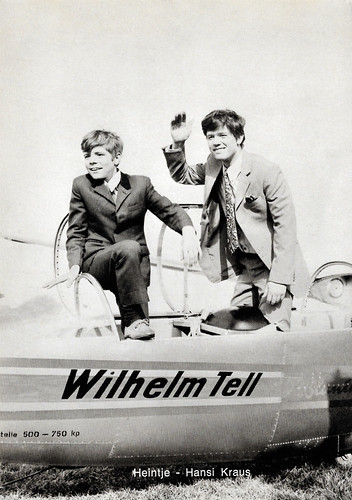
German postcard by Franz Josef Rüdel, Filmpostkartenverlag, Hamburg, no. 5132. Photo: Constantin / Seitz / Klaus. Heintje and Hansi Kraus in Hurra, die Schule brennt - Die Lümmel von der ersten Bank IV. Teil/Hurrah, the School Is Burning (Werner Jacobs, 1969).
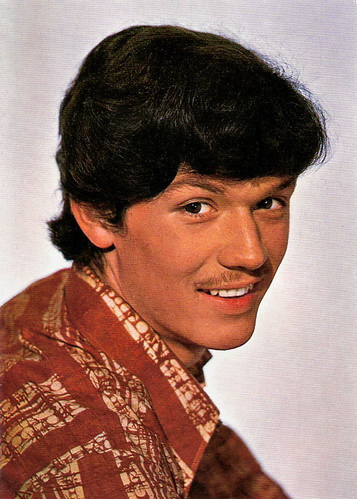
German postcard. Photo: Constantin / Lisa / Vogelmann. Hansi Kraus in Kinderarzt Dr. Fröhlich/Pediatrician Dr. Fröhlich (Kurt Nachmann, 1971).
The Pranks of a Young Scamp
Hans Kraus was born as Hans Krause in 1952 in Gliwice, Poland.
He made his film debut as a child in the Romanian film Strainul/The Stranger (Mihai Iacob, 1964), with Stefan Iordache and Irina Petrescu. The film was acclaimed at the Karlovy Vary International Film Festival in 1964.
As Hansi Kraus, he became known for the German comedy Lausbubengeschichten/Tales of a Young Scamp (Helmut Käutner, 1964). Hans Krause sounded too Prussian to play a Bavarian character, so producer Frans Seitz decided to use the screen name 'Hansi Kraus'.
The film was based on the satiric short stories by Bavarian author Ludwig Thoma (1867-1921). He based his 'Lausbubengeschichten' (literally 'Little Scoundrel's Tales') on his own childhood, growing up in rural Oberammergau at the time of the demise of King Ludwig II of Bavaria. Kraus played the scoundrel Ludwig for whose incessant tricks and pranks nobody is safe: be it arrogant Prussian tourists, stern teachers, the superstitious village-priest or Ludwig's nagging aunt.
The urban setting and the all-star cast with Heidelinde Weis , Käthe Braun, and Georg Thomalla , struck a chord with German filmgoers and Lausbubengeschichten/Tales of a Young Scamp (Helmut Käutner, 1964) became a hit at the box-office, spawning five sequels, such as Tante Frieda - Neue Lausbubengeschichten/Aunt Frieda - New Tales of a Young Scamp (Werner Jacobs, 1965) with Elisabeth Flickenschildt, and Wenn Ludwig ins Manöver zieht/When Ludwig goes into maneuver (Werner Jacobs, 1967).
T. Atzmueller at IMDb : "Of course, by today's standards Ludwig's pranks are generally harmless fun, always targeting particularly bigoted or deserving victims. (...) Non-German/-Bavarian viewers might ask themselves what all the fuzz was about. Lausbubengeschichten is a strictly local affair and it would require some background-knowledge of time and area to understand all the puns and inside jokes."
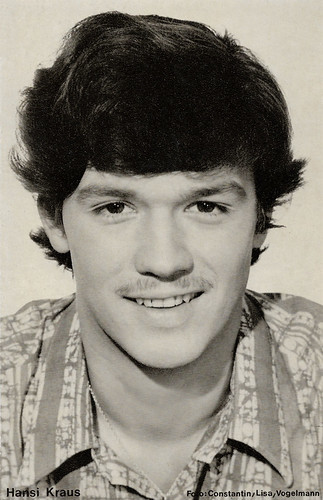
German postcard by Franz Josef Rüdel, Filmpostkartenverlag, Hamburg, no. 5213. Photo: Constantin / Lisa / Vogelmann. Hansi Kraus in Kinderarzt Dr. Fröhlich/Pediatrician Dr. Fröhlich (Kurt Nachmann, 1971).
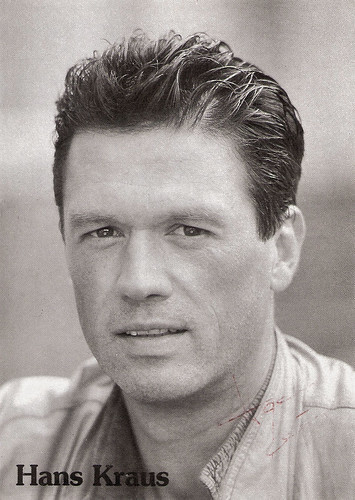
German card. Photo: Joachim von Czarnowski.
A series of the usual adolescent, cheap and boring jokes
After the reservoir of Thomas's scoundrel stories was depleted, Hansi Kraus was cast in numerous other films in the same genre. Very popular were the seven 'Lümmelfilme' ('Lümmel' is another word for youthful scoundrel), where he played Pepe Nietnagel, a student who, together with his classmates, plays pranks on his teachers and other adults.
The first film was Die Lümmel von der ersten Bank - 1. Trimester: Zur Hölle mit den Paukern/The louts from the first bench - 1st trimester: To hell with the teachers (Werner Jacobs, 1968) also with Gila von Weitershausen and Theo Lingen .
J. Steed at IMDb : "on the whole, the film is no more than a series of the usual adolescent, cheap and boring jokes and the usual petty love affair. The script is just acceptable with only a hint of a story; in fact, it is no more than a series of events, wearisome held together by director Werner Jacobs who directs in his well-known "as long as it is on the celluloid" style. (...) It must be said that compared to the sequels (and other films prompted by the "Lümmel films") this episode is not made badly at all - the quality such as there is would deteriorate in the sequels".
Some 25 years later, he again assumed the role of the now grown-up Pepe Nietnagel in three episodes of the Austrian TV series Ein Schloß am Wörthersee/Lakeside Hotel (1991-1992).
Being typecast as a scoundrel didn't do the young actor very well. Hansi Kraus would later admit, that the industry virtually dropped him after growing up. His later films included only the Thomas Mann adaptation Unordnung und frühes Leid/Disorder and Early Torment (Franz Seitz, 1977) with Martin Held , the dismal comedy Big Mäc (Sigi Rothemund, 1985) starring TV host Thomas Gottschalk, and another disastrous comedy Starke Zeiten/Strong Times (Sigi Rothemund a.o., 1988) with another TV personality, this time Rudi Carrell .
Kraus fared better on stage and on television in such series as Waldhaus/Forest house (1987-1988) with Loni von Friedl, Löwengrube/Lion's den (Rainer Wolffhardt, 1990-1992), and the comedy series Zum Stanglwirt (1993-1997). He was now credited as Hans Kraus.
In the new century, he continued to act on television, including a long-time stint in Forsthaus Falkenau (1994-2010). He appeared in 125 episodes of the popular drama series, starring Christian Wolff . His most recent film is the comedy Schmucklos (Thomas Schwendemann, 2019).
Hans Kraus is the father of two daughters, including actress Miriam Krause.
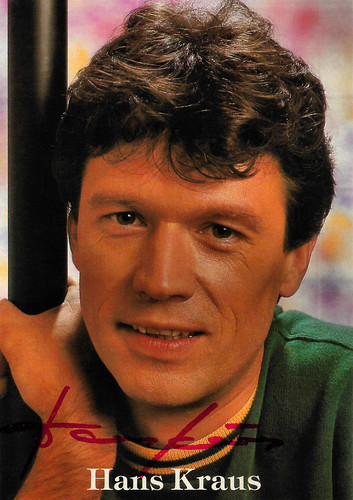
German autograph card by Simon Offset, München.

German autograph photo.
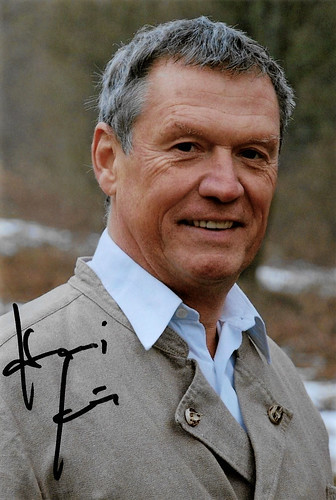
German autograph photo, 2019.
Sources: T. Atzmueller (IMDb), J. Steed (IMDb), Wikipedia (English and German), and .
October 14, 2020
Directed by Joe May
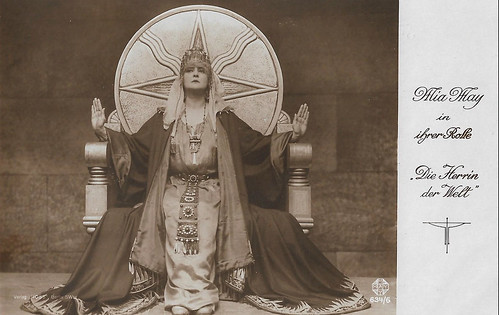
German postcard by Ross Verlag, no. 634/6. Photo: May Film. Mia May in Die Herrin der Welt/Mistress of the World (Joe May and others, 1919).
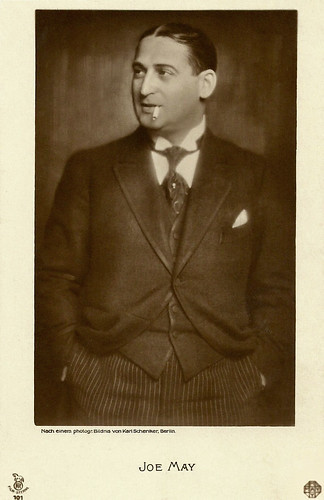
German postcard by Rotophot in the Film Sterne series, no. 101. Photo: Karl Schenker / May-Film. Joe May.
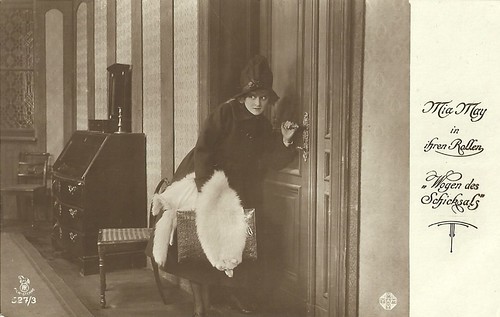
German postcard by Rotophot in the Film Sterne series, no. 527/3. Photo: May Film. Mia May in Wogen des Schicksals/Waves of fate (Joe May, 1918).
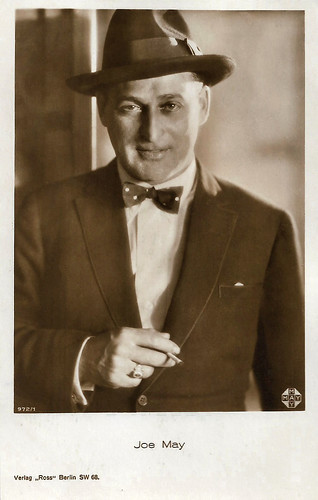
German postcard by Ross Verlag, no. 972/1, 1925-1926. Photo: May-Film. Joe May.
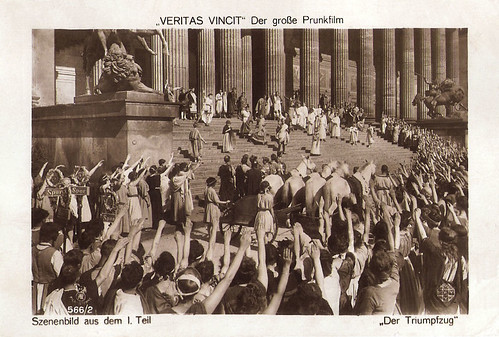
German postcard by Rotophot in the Film-Sterne series, no. 566/2. Photo: May-Film. Publicity still for Veritas Vincit (Joe May, 1919). Caption: A scene from the First Part, The triumphal procession.

German postcard by Ross Verlag, Berlin, no. 398/1, 1919-1924. Photo: Alex Binder / May Film.
Eva May (1902-1924) was the daughter of film star Mia May and producer Joe May. It was only natural that she would follow suit. She became ‘everybody’s darling’ but in 1924 she committed suicide.
A series of popular and exotic adventures
Joe May was born Otto Julius Mandl (according to IMDb , Joseph Otto Mandel) in Vienna, Austria-Hungary (now Austria), in 1880. He was born into a rich family.
After his study in Berlin, he had many odd jobs. In 1902 he married the Viennese actress Mia May (born Hermine Pfleger) and later took his stage name from hers. In 1909, he worked as an operetta director in Hamburg, and there he got in touch with the film business.
His entrance in the film business was an unusual one. When he directed the play 'Clo Clo' the intermissions were very long because of the reconstructions of the sets. Audiences did not know if the play had ended or not and sometimes left the theatre too early. Therefore Mandl got the idea to entertain the audience during the intermission with a short film with the actors of the play. Although inexperienced, he was able to make this film.
As Joe May, he then made ten films for Continental-Kunstfilm GmbH in Berlin. The first was In der Tiefe des Schachtes/In the Depths of the Pit (Joe May, 1912), in which Mia May made her film debut. It was followed by Vorglühen des Balkanbrandes/The Balkan Traitors (Joe May, 1912), starring Ernst Reicher .
In the spring of 1914 May directed the first three of the 'Stuart Webbs' films, a popular series in which Ernst Reicher played a gentleman detective modelled on Sherlock Holmes: Die geheimnisvolle Villa/The Black Triangle (Joe May, 1914), Der Mann im Keller/The Man in the Cellar (Joe May, 1914), and Der Spuk im Haus des Professors/The Spook in the Professor's House (Joe May, 1914).
May and Reicher fell out with the managers of Continental over the 'Stuart Webbs' films, and they left Continental together. They formed their own production company, Webbs-Film, and made the next in the 'Stuart Webbs' series, Das Panzergewölbe/The Armoured Vault (Joe May, 1914), using Continental-Kunstfilm's new studios at 9 Franz Joseph-Strasse, Weissensee for the filming.
When the First World War broke out in August 1914, May had to return to his native Vienna to do his military service, and on his return to Berlin he and Reicher split up. Ernst Reicher leased the studio at 9 Franz Joseph-Strasse from Continental, and continued to make the 'Stuart Webbs' films with his Reicher & Reicher company until 1918. May's last film at Continental was Der geheimnisvolle Nachtschatten/The Secret Shadows of Night (1914) which he produced and Harry Piel directed.
In 1915 he founded his own film production company, May-Film Gmb, and began to produce a successful series of crime films, whose detective hero went by the name of Joe Deebs. Some of these were directed by May himself, others by Harry Piel . Max Landa and later Harry Liedtke played the title role. May was not only active as a director and a producer but also as a screenwriter. For several screenplays, he used the pen name Fred Majo.
In 1917 May gave Fritz Lang one of his earliest breaks in the film industry as a screenwriter on Die Hochzeit im Excentricclub/Wedding in the Eccentric Club (Joe May, 1917), a film in the Joe Deebs series. Lang also worked on other May films at this time. May also discovered such talents as Thea von Harbau and E.A. Dupont for the cinema.
After the end of the First World War, May-Film leased the double glasshouse studios belonging to Deutsche Vitascope in 1919, which became known as the May-Atelier. May also built a film studio in Woltersdorf a village northeast of Berlin in Brandenburg. There he continued to produce and direct a series of popular and exotic adventures, including the monumental Veritas vincit (Joe May, 1919), an epic in three episodes, similar to D. W. Griffith's Intolerance (1916), and the 8-part serial Die Herrin der Welt/Mistress of the World (Joe May, a.o., 1919-1920).
Another epic was the two-part adventure film Das indische Grabmal/The Indian Tomb (Joe May, 1921) starring Conrad Veidt and Lya de Putti . The film was scripted by Fritz Lang and Thea von Harbou. Upon its release, it was neither a critical nor commercial success and has been little seen until two recent restorations were recently completed.
Mia May became a popular star in a number of melodramas under her husband's direction such as Hilde Warren und der Tod/Hilde Warren and Death (Joe May, 1917) and Tragödie der Liebe/Tragedy of Love (1922-1923) with Emil Jannings .
Their daughter Eva May , born in Vienna in 1902, was successful as an actress as well. Sadly, she committed suicide in 1924 after the failure of her three marriages with the film directors Manfred Liebenau, Lothar Mendes and Manfred Noa.
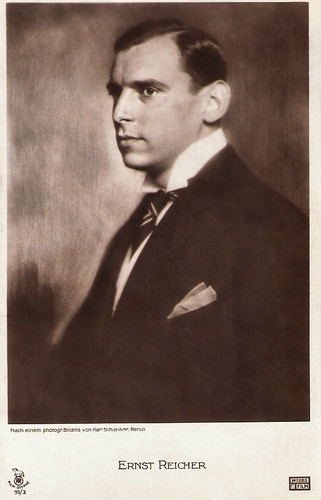
German postcard by Rotophot in the Film Sterne series, no. 94/3. Photo: Karl Schenker / Webbs Film. Ernst Reicher as Stuart Webbs.
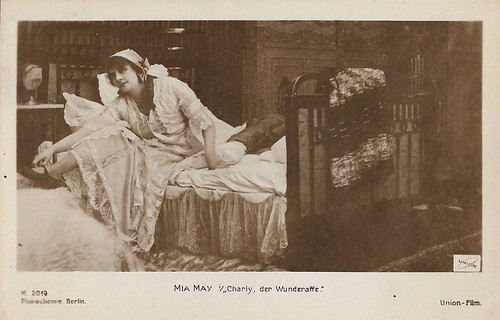
German postcard by Photochemie, Berlin, no. K. 2019. Photo: Union-Film. Mia May in Charley, der Wunderaffe/Charley, the Magic Monkey (Joe May, 1915).
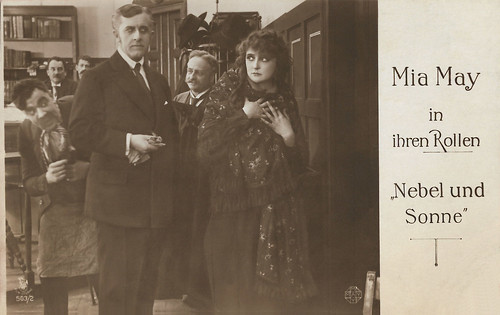
German postcard in the Film-Sterne series by Rotophot, no. 503/2. Photo: May Film. Mia May and Hans Mierendorff in Nebel und Sonne (Joe May, 1916). The film narrates about the martyrdom of a mother.
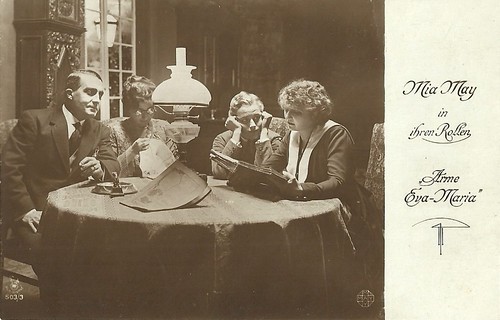
German postcard by Rotophot in the Film Sterne series, no. 503/3. Photo: May-Film. Mia May in Arme Eva Maria/Poor Eva Maria (Joe May 1916). Princess Eva Maria ( Mia May ) elopes to escape an arranged marriage with a prince and marries a painter, Hans Flotow ( Harry Liedtke ). Yet, Flotow proves to be unreliable and superficial, burns her capital, and dumps her for a singer. Deluded, Eva Maria returns to her class and marries a baron and landowner.
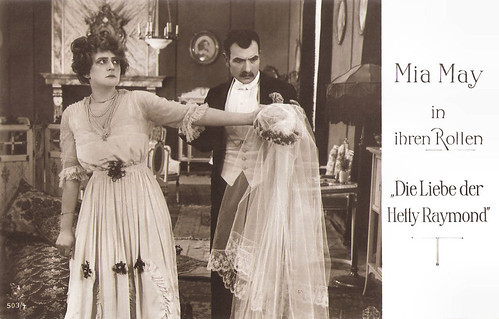
German postcard by Rotophot in the Film Sterne series, no. 503/4. Photo: May-Film. Mia May in Die Liebe der Hetty Raymond/The Love of Hetty Raymond (Joe May, 1917).
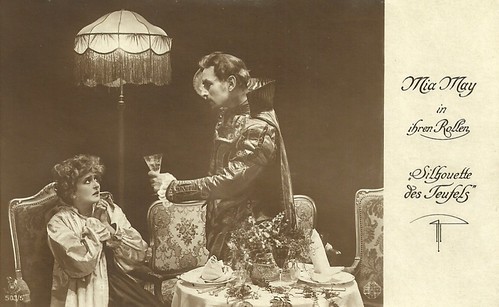
German postcard in the Film Sterne series by Rotophot, no. 503/5. Photo: May-Film. Mia May and Bruno Decarli in Die Silhouette des Teufels (Felix Basch, 1916-1917), produced and scripted by Joe May.
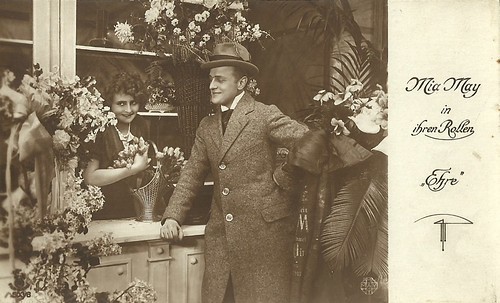
German postcard in the Film-Sterne series by Rotophot, no. 503/6. Photo: May Film. Mia May and Harry Liedtke in Ehre/Honour (Joe May?, Hans Oberländer?, 1917).
Frictions about his dictatorial behaviour on the set
Towards the end of the 1920s, Joe May left the adventure genre and focused on realist films, such as Heimkehr/The Return Home (Joe May, 1928), with Dita Parlo , Lars Hanson , and Gustav Fröhlich , and the contemporary comical thriller Asphalt (Joe May, 1929), starring Gustav Fröhlich and Betty Amann .
During the early sound film years, May worked as a producer for Erich Pommer at Ufa and afterward for several other companies in Germany, Austria, and France, directing a series of multilanguage films in German and French. HisIhre Majestät die Liebe/Son Altesse l'amour (1930) was one of the best musical comedies of the Weimar era. It starred Käthe von Nagy and Franz Lederer in the German version and Annabella and Roger Tréville in the French version.
In 1933 May, his wife, and many colleagues emigrated to the US, where he was capable with help of former Ufa head Erich Pommer to establish himself as director and made Music in the Air (Joe May, 1934), based on Jerome Kern and Oscar Hammerstein II's Broadway musical of the same name. The film, starring Gloria Swanson, was a commercial failure, and May's later work at Universal Pictures, would never result in A-pictures.
His next Hollywood film was the Kay Francis vehicle Confession (Joe May, 1937), an exact remake of the German film Mazurka (Willi Forst, 1935), starring Pola Negri, which Warner Brothers Studios acquired the U.S. distribution rights for and then shelved in favour of the remake. However it was not a box office success. May's later films were the Gothic drama The House of the Seven Gables (Joe May, 1940), and The Invisible Man Returns (Joe May, 1940) starring Vincent Price .
He also worked on two films with The Dead End Kids, You’re Not So Tough (Joe May, 1940), and Hit the Road (Joe May, 1941), despite frictions with his young stars because of his dictatorial behaviour on the set. May also never bothered to completely learn the English language. His last film was Johnny Doesn’t Live Here Anymore (Joe May, 1944) with Simone Simon made by the King Brothers and released through Monogram Pictures.
After his retirement in 1950, Joe May and his wife Mia ran for a short time The Blue Danube Restaurant in Los Angeles, which specialised in the Viennese kitchen. According to Doug Sederberg at IMDb , "it failed because, in keeping with his Teutonic roots, May told customers what they should order."
After the restaurant closed, May and his wife had to rely on the support of their friends and colleagues as well as the aid organization European Film Fund. Joe May died in 1954 after a long illness at the age of 67. He is interred in the Hollywood Forever Cemetery in Hollywood, California.
Curd Goetz, who wrote some screenplays for the Joe Deebs Series, remembers the following anecdote in his autobiography: Joe May was directing a scene where, at the shore of a lake, an elephant was required to enter the camera's view from the side. However, the animal trainer did not manage to make it do so. May, fully immersed in making the scene, got impatient and started to pull the animal by its trunk. The elephant, more annoyed than angry, effortlessly picked him up and threw him, in a high arc, into the lake. May, airborne, only screamed: "Stay shooting!".
In November 2018, the Cinefest Festival and the CineGraph Congress in Hamburg presented Joe May as an important producer and film mogul. In addition, May's two-part Das indische Grabmal/The Indian Tomb (Joe May, 1921-1922), was restored by the Friedrich-Wilhelm-Murnau-Stiftung and appeared for the first time in Germany on DVD and Blu-ray in 2019.
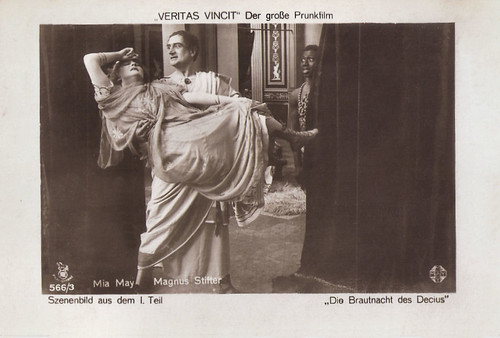
German postcard by Rotophot in the Film Sterne series, no. 566/3. Photo: May Film. Mia May and Magnus Stifter in Veritas Vincit (Joe May, 1919). Caption: Decius' Wedding Night.
Veritas vincit (Joe May, 1919) was a prestigious monumental, three-part film on the victory of truth through the ages. The first part evolves during Roman Antiquity, the second during the Middle Ages, while the last part takes place at a small European court shortly before the First World War. In the first two parts, the protagonists sign their fates because of insincerities, causing fate to take a tragic turn. In the modern episode, the female protagonist has learned from her predecessors. By being sincere she saves her love and conquers prejudice. The giant sets for the film were designed by Paul Leni. The film was shot during the last months of the First World War and premiered on 4 April 1919 in Berlin.
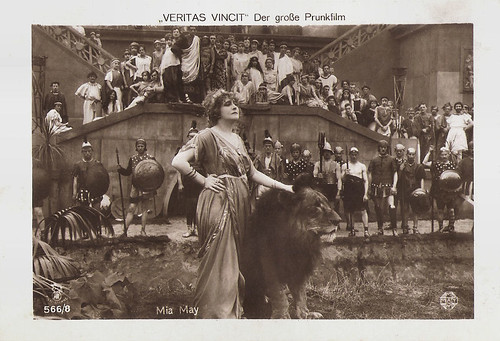
German postcard by Rotophot in the Film Sterne series, no. 566/8. Photo: May Film. Mia May in the first part of Veritas Vincit (Joe May, 1919).
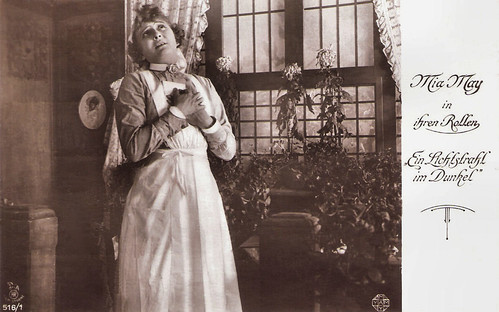
German postcard in the Film Sterne series by Rotophot, no. 516/1, 1919-1924. Photo: May-Film. Mia May in Ein Lichtstrahl im Dunkel/A ray of light in the darkness (Joe May, 1917).
In Ein Lichtstrahl im Dunkel/A ray of light in the darkness (Joe May, 1917), count Gerd Palm ( Bruno Kastner ) is known for his flattering portraits of his models, so countess Lydia von Grabor ( Mia May ), who has a hideous nose, asks him to paint her. Gerd sees through her facade and paints her as a lovely mother. He is so enchanted by a song from her that he asks her to marry him. Lydia cannot believe him, so she flees. Years pass, the countess has her nose operated, and returns to Gerd, but discovers he has become blind. Dressed as a nurse she takes care of him. Her care makes him retake his work. He hears she is now ready to marry him, but when he still doubts she sings the song she once sang for him and they finally unite.
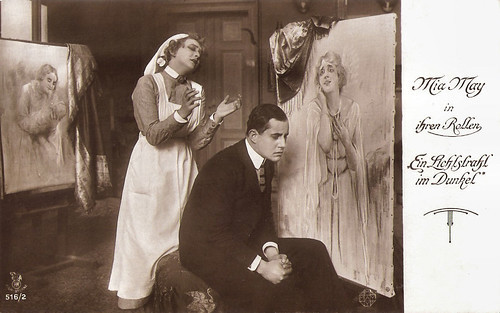
German postcard by Rotophot in the Film Sterne series, no. 516/2. Photo: May-Film. Mia May and Bruno Kastner in Ein Lichtstrahl im Dunkel/A Ray of Light in the Dark (Joe May, 1917).
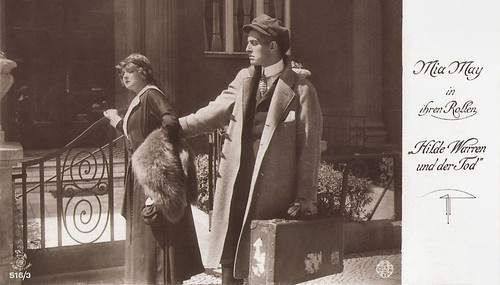
German postcard by Rotophot in the Film Sterne series, no. 516/3, 1919-1924. Photo: May-Film. Mia May and Bruno Kastner in Hilde Warren und der Tod/Hilde Warren and Death (Joe May, 1917), scripted by Fritz Lang.
In Hilde Warren und der Tod/Hilde Warren and Death (Joe May, 1917), the famous actress Hilde Warren (Mia May) rejects the marriage proposal of her theatre manager ( Hans Mierendorff ), preferring her art. When Death (Georg John) tempts her, she rejects him. She falls in love with the handsome criminal Hector Roger ( Bruno Kastner ), who dies in a shootout with the police. Hilde is desperate when she discovers she is bearing his child, so Death visits her again, but in vain. Years after, the father’s vices seem inherited in their son Egon, and Hilde feels she is responsible. The theatre manager still wants to marry Hilde, but she cannot accept his condition to abandon her son. Death visits her third time but to no avail. The spoiled Egon ( Ernst Matray ), once an adult, turns into a criminal when Hilde refuses him money. Fleeing for the police, he asks his mother for money to get away, but she menaces him with a gun. In a fight, she shoots him. Condemned to jail, she finally welcomes Death.
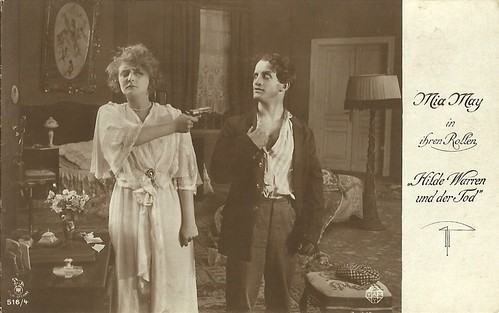
German postcard by Rotophot in the Film Sterne series, no. 516/4, 1919-1924. Photo: May-Film. Mia May and Ernst Matray in Hilde Warren und der Tod/Hilde Warren and Death (Joe May, 1917), scripted by Fritz Lang.
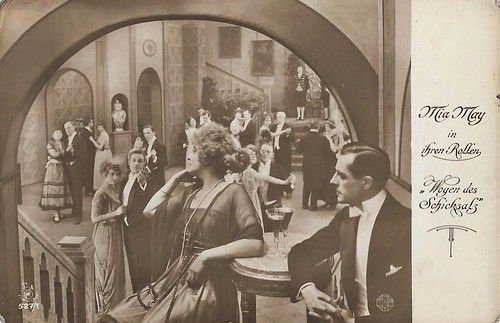
German postcard by Rotophot in the Film Sterne series, no. 527/5. Photo: May Film. Mia May in Wogen des Schicksals/Waves of Fate (Joe May, 1918). The man on the dance floor signing to her is Erich Kaiser-Titz , while the man sitting next to Mia May is Rolf Brunner.
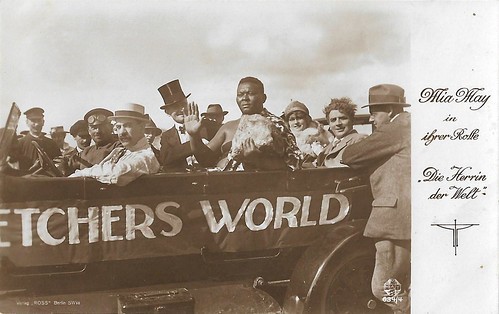
German postcard by Ross Verlag, no. 634/6. Photo: May Film. Mia May and Michael Bohnen in Die Herrin der Welt/Mistress of the World (Joe May and others, 1919).
In 1919, Joe May, Joseph Klein, Uwe Jenss Krafft, and Karl Gerhardt shot the various episodes for the eight-part German silent serial Die Herrin der Welt, one of the most notable adventure series of the Weimar cinema and considered the first monumental film in German film history. The Star of the film was Mia May , her male film partner was played by Michael Bohnen. May shot episodes 1, 2, 3, and 8, Krafft 4 to 6, and Gerhardt 7. Klein was co-director for parts 1 and 4. The Indiana Jones-like story follows the young Maud Gregaard on her globe-trotting adventures to find the legendary lost treasure of the Queen of Sheba. She hopes it will enable her to bring revenge on the man that drew her father to commit suicide and led to her own social destruction. All eight parts were full-length. Even if self-sustaining features they referred to future developments though without American styled cliffhangers. Even if part of the press was critical, German audiences loved it and it was a bigger box office than the contemporary The Cabinet of Dr. Caligari.
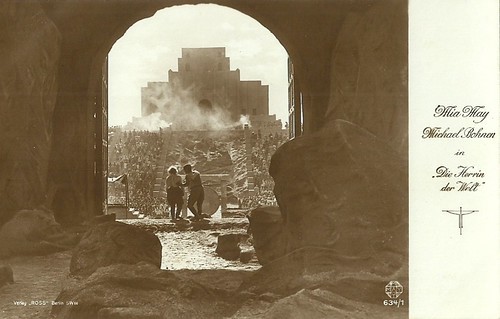
German postcard by Ross Verlag, no. 634/1. Photo: May Film. Mia May and Michael Bohnen in Die Herrin der Welt/Mistress of the World (Joe May and others, 1919).
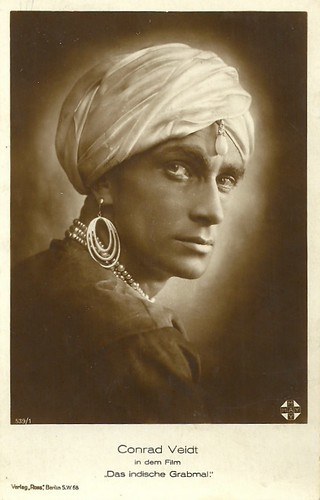
German postcard by Ross Verlag, no. 539/1. Photo: May-Film. Conrad Veidt as the proud and cruel Maharajah of Eschnapur in the two-part monumental film Das indische Grabmal/The Indian Tomb (Joe May, 1921-1922).
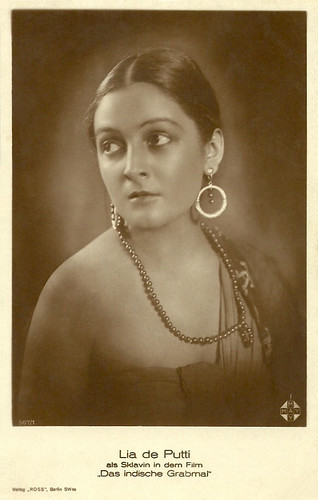
German postcard by Ross Verlag, Berlin, no. 567/1, 1919-1924. Photo: May-Film. Lya de Putti as the slave Mirrjha in Das Indische Grabmal/The Indian Tomb (Joe May, 1921). Collection: Didier Hanson.
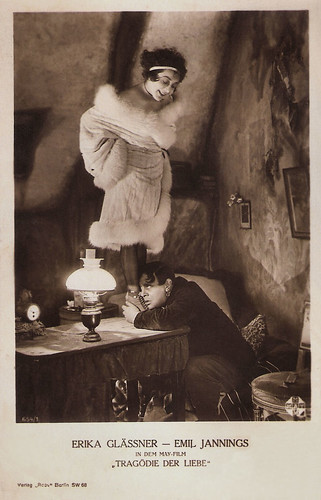
German postcard by Ross Verlag, no. 654/1. Photo: May Film. Erika Glässner and Emil Jannings in Tragödie der Liebe/The Tragedy of Love (Joe May, 1923).
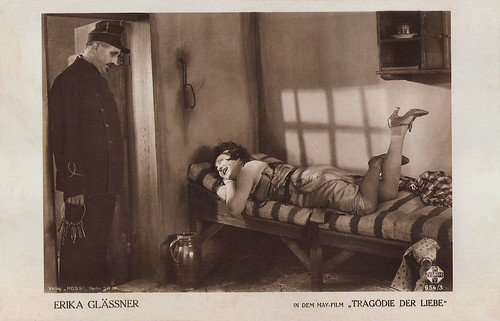
German postcard by Ross Verlag, no. 654/3. Photo: May Film. Erika Glässner in Tragödie der Liebe/The Tragedy of Love (Joe May, 1923).
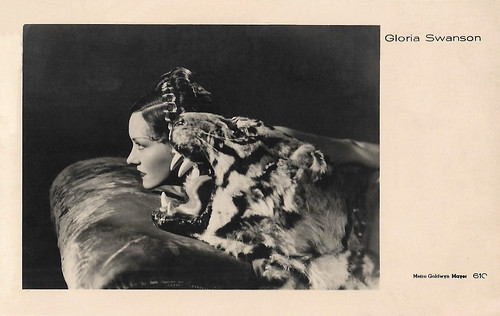
Dutch postcard, no. 610. Photo: Metro Goldwyn Mayer. In 1934 Gloria Swanson did a photoshoot involving this tiger rug and hairdo, before acting in the Jerome Kern musical Music in the air (Joe May, 1934). While some sources say the photos were made by Clarence Sinclair Bull, other sources don't mention the photographer.
Sources: (IMDb), Wikipedia (French, German, and English), and .
October 13, 2020
Erica Beer
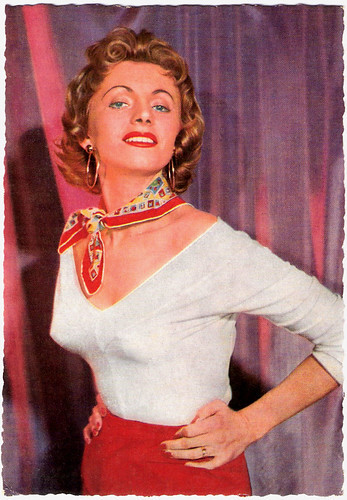
West-German postcard by WS-Druck, Wanne/Eickel, no. ?26. Photo: Klaus Collignon.
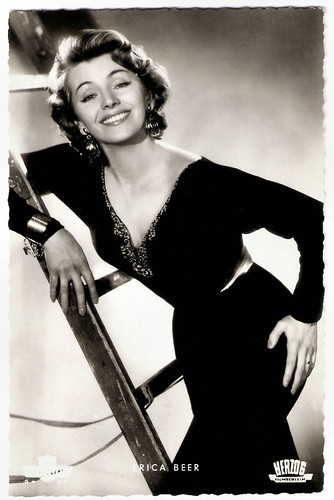
West-German postcard by Kunst und Bild, Berlin, no. V 388. Photo: Berolina / Herzog-Film / Wesel. Erica Beer in Schwarzwaldmelodie/Black Forest Melody (Géza von Bolváry, 1956).
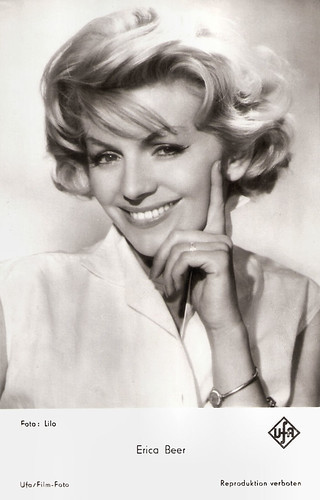
West-German postcard by UFA/Film-Foto, Berlin-Tempelhof, no. FK 4657. Photo: Lilo.
The New Blue Angel
Erica Konstanze Beer was born in Munich, Germany in 1925. She was the daughter of merchant Joseph Beer and his wife Katharina Konstanzia Faltermeier. Erica trained to become a nurse and also took acting lessons with Beate von Molo.
She started her career on the Munich stage at the Kleine Komödie. In 1949 her son, Michael Konstantin, was born. His father was an American. Beer worked on stage in German cities as Bonn, Darmstadt, Frankfurt, Stuttgart, Wiesbaden, and Munich, where she played at the famous Kammerspiele. She also appeared in Switzerland.
Among her most successful plays were stage versions of the films Born Yesterday, Ninotschka and Der blaue Engel/The Blue Angel. The German press hailed her as a cross between Marilyn Monroe and Marlene Dietrich .
In 1952 she made her film debut in the drama Gefangene Seele/Captured Soul (Hans Wolff, 1952) with Attila Hörbiger .
From then on, she played supporting parts in several German films, often as a seductive vamp. In 1954, it was announced that she would star in the remake of The Blue Angel. The part eventually went to May Britt .
In 1956, she finally had her first lead role in a film, in the mediocre Heimatfilm Schwarzwaldmelodie/Black Forest Melody (Géza von Bolváry, 1956) opposite Claus Biederstaedt . The film was not a success and Beer continued to play supporting parts.
In 1957, she married internationally renowned, Austrian-born screenwriter Robert T. Thoeren. He was 21 years her senior and had a daughter, Nina, from a previous marriage to a French painter. Thoeren adopted Erica’s young son. Later that year Thoeren died at age 53 from a cardiac weakness following a car crash while driving from Munich to Zurich.
The next year Erica visited Hollywood. Actor William Holden invited her to his pool, and producer Sam Spiegel escorted her to the theatre. She was considered to play in the upcoming The Guns of Navarone. Again, nothing came from it.
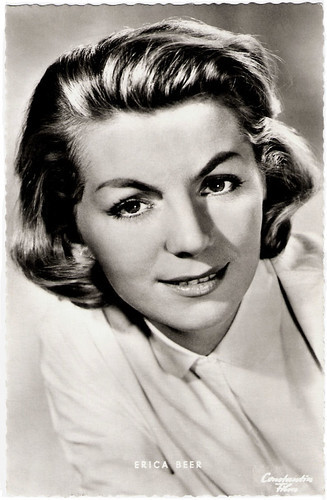
West-German postcard by Kunst und Bild, Berlin, no I 223. Photo: Constantin Film / Bockelberg. Erica Beer in Flucht in die Tropennacht/Escape in the tropical night (Paul May, 1957).
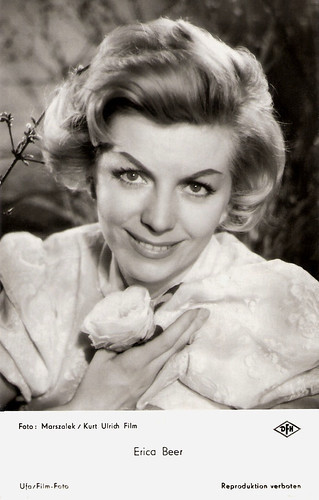
West-German postcard by Ufa/Film-Foto, Berlin-Tempelhof, no. FK 4490. Photo: Marszalek / Kurt Ulrich Film / DFH. Erica Beer in So angelt man keinen Mann/That's No Way to Land a Man (Hans Deppe, 1959).
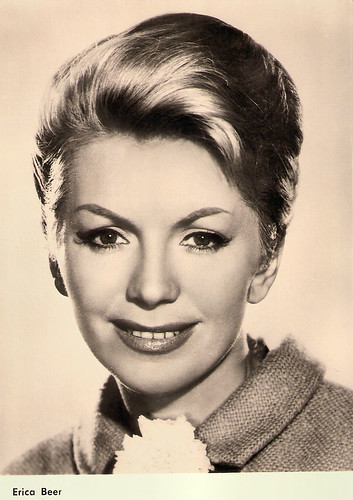
East-German postcard by VEB Progress Film-Vertrieb, Berlin, no. 1754, 1962. Erica Beer in Im sechsten Stock/On the sixth floor (John Olden, 1961).
Child Kidnapper
In 1960, Erica Beer’s 18-year-old stepdaughter Nina was murdered by a sex offender, who gave her a ride home from her university in Los Angeles. Beer inherited the fortune, left by Thoeren to his daughter in 1957. She then received a phone call ordering her to pay 20,000 DM to prevent her son from being kidnapped. The threat turned out to be a hoax by her former astrologer, Wilhelm Grasmugg.
She returned to Germany where she appeared on the Munich stage in 'Die Comtessa Coralli' (Countess Coralli). She also played in more German films. In the Edgar Wallace Krimi Der rote Kreis/The Crimson Circle (Jürgen Roland, 1960), she played a child kidnapper.
On TV she was seen in the mini-series Das Halstuch/The Scarf (Hans Quest, 1962), based on a thriller by Francis Durbridge. The series became a phenomenal success. Stephanie D’heil at Steffi-line writes: “It was real mass hypnosis. The six episodes each took only 35 to 40 minutes but the mystery kept the spectators at home. Towns and villages seemed deserted. Bar owners, club presidents, adult education school teachers, theatre and cinema owners, all faced an empty house in the evenings the series was transmitted on TV. In modern words it was a blockbuster. The legendary Krimi blew up everything in the young history of television.”
Then, Beer finally did co-star with William Holden in an American production, the spy thriller The Counterfeit Traitor (George Seaton, 1962), shot in Germany and Scandinavia. Her later films include the comedy DM-Killer (Rolf Thiele, 1965) starring Curd Jürgens , and Nicht fummeln Liebling/No Pawing, Darling (May Spiels, 1970) with Gila von Weitershausen.
More interesting were two English-language films she made with Polish director Jerzy Skolimowski. Deep End (Jerzy Skolimowski, 1970) is a beautiful Coming-of-Age drama in which a teen-aged London bathhouse attendant (John Moulder-Brown) falls in love with an older colleague (Jane Asher). Hal Erickson writes at AllMovie : “Deep End observes how adolescent obsession can mushroom into disaster if one doesn't have the emotional equipment to cope”.
In King, Queen, Knave (Jerzy Skolimowski, 1972), young orphan Frank (John Moulder Brown) finds himself deep in the romantic clutches of the sensual wife ( Gina Lollobrigida ) of his uncle ( David Niven ). This satirical drama was based on a novel by Vladimir Nabokov. In all these films, Beer merely played supporting parts.
Throughout the next decades, she continued to appear on the Munich stages and incidentally on TV. Her final role was in the European television crime TV-series Eurocops (1989) with Heiner Lauterbach .
In 2013, Erica Beer passed away in Vaterstetten in Bavaria, Germany. She was 88.
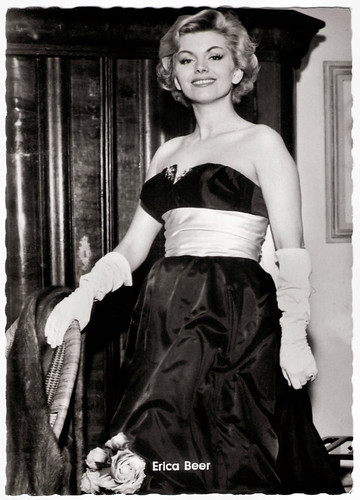
West-German postcard by Agfa, no. 575. Photo: Erwin Schneider.
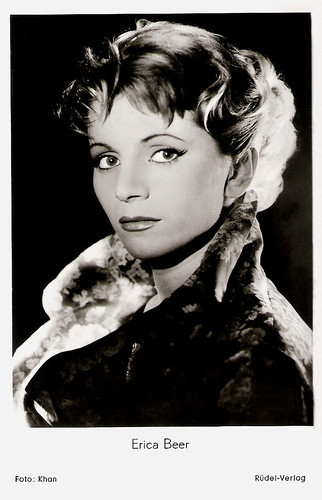
West-German postcard by Rüdel-Verlag, Hamburg-Bergedorf, no. 2498. Photo: Khan.
Scene from The Counterfeit Traitor (1962). Source: MovieClips (YouTube).
Trailer Deep End (1970). Source: TrailerHousePoP (YouTube).
Sources: Stephanie D’heil (Steffi-line - German), Hal Erickson (AllMovie), Glamour Girls of the Silver Screen, Wikipedia (German) and .
October 12, 2020
The Prison Without Walls (1917)
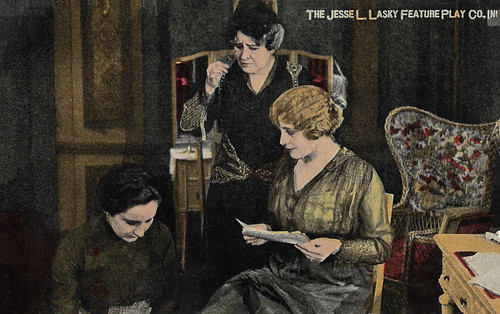
Spanish cromo by Chocolat Imperiale, no. 1 of 6. Photo: Jesse Lasky / Paramount. Myrtle Stedman and Camille Ankewich in The Prison Without Walls (E. Mason Hopper, 1917). The old lady was possibly Lillian Leighton.
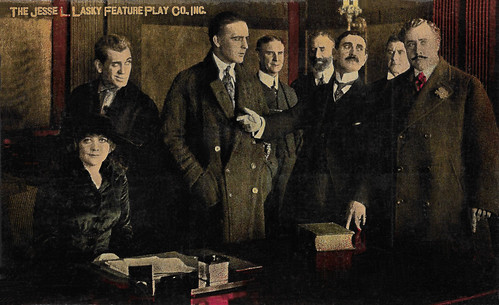
Spanish cromo by Chocolat Imperiale, no. 2 of 6. Photo: Jesse Lasky / Paramount. Myrtle Stedman, Wallace Reid, and William Conklin in The Prison Without Walls (E. Mason Hopper, 1917).
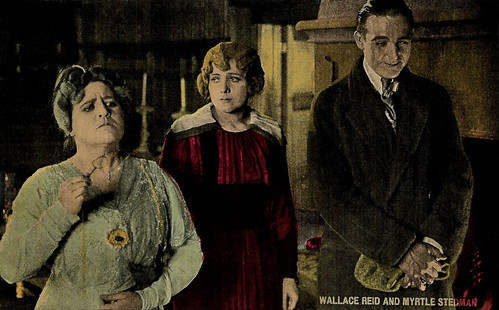
Spanish cromo by Chocolat Imperiale, no. 3 of 6. Photo: Jesse Lasky / Paramount. Myrtle Stedman and Camille Ankewich in The Prison Without Walls (E. Mason Hopper, 1917). The old lady was possibly Lillian Leighton.
Undercover as an ex-con
In The Prison Without Walls (E. Mason Hopper, 1917) Myrtle Stedman plays Heiress Helen Ainsworth, who is deeply committed to prison reform work.
Norman Morris (William Conklin), the administrator of the Ainsworth millions, who is in reality involved in prison graft, uses his relation to Helen, to whom he is engaged, to visit the prisons with her and collect his share of the take.
Meanwhile, Huntington Babbs (Wallace Reid), a prison expert, has been employed by the governor to continue his liberal prison policy, which has been assailed by Morris and his friends. Babbs goes undercover posing as Conroy, an ex-con, who is hired by Helen as her secretary, thus enabling him to spy on Morris.
Morris is jealous of the good-looking secretary and he makes Helen's maid Felice (Camille Ankewich), an ex-convict, 'plant' a necklace which he has presented to Helen, in Babbs' room. Babbs discovers the plot, and Morris, overhearing his plan to visit a certain place in the rough part of the city, for Helen, plans to get him. He orders the gang to murder him.
When the Ainsworth safe is burglarised and the tools found in Conroy's possession, things look bleak until several of Morris' accomplices incriminate Morris in the crime.
With Morris eliminated, Babbs reveals his true identity and proclaims his love for Helen.
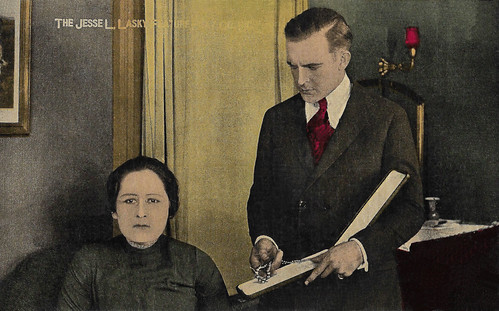
Spanish cromo by Chocolat Imperiale, no. 4 of 6. Photo: Jesse Lasky / Paramount. Wallace Reid and Camille Ankewich in The Prison Without Walls (E. Mason Hopper, 1917).
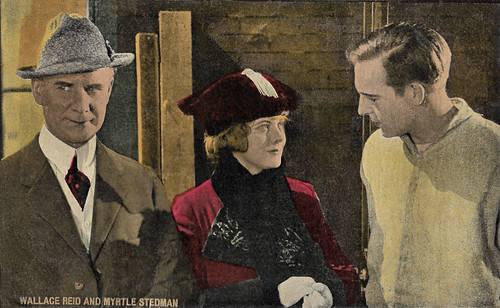
Spanish cromo by Chocolat Imperiale, no. 5 of 6. Photo: Jesse Lasky / Paramount. Wallace Reid and Myrtle Stedman in The Prison Without Walls (E. Mason Hopper, 1917). The old man may be James Neill.
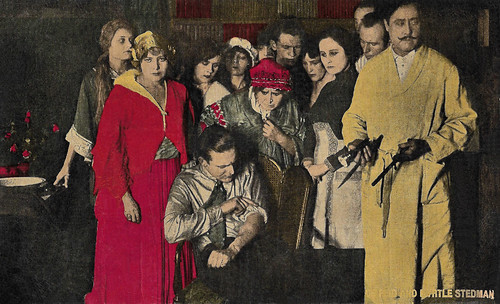
Spanish cromo by Chocolat Imperiale, no. 6 of 6. Photo: Jesse Lasky / Paramount. Myrtle Stedman, Wallace Reid, Camille Ankewich, and William Conklin in The Prison Without Walls (E. Mason Hopper, 1917). The old lady was possibly Lillian Leighton.
Source: AFI, Wikipedia, and IMDb.
October 11, 2020
Knighthood for Tommy Steele

German postcard by ISV, no. H 14.
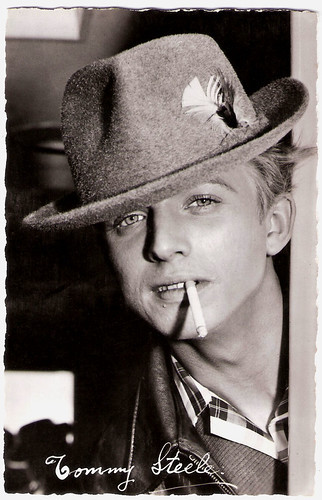
Vintage postcard.

Dutch postcard by Takken, Utrecht, no. 3248.
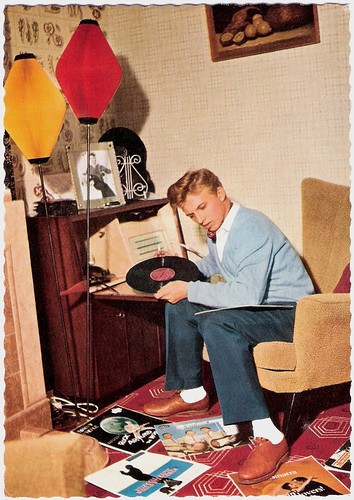
West-German postcard by Ufa/Film-Foto, Berlin-Tempelhof, no. CK 345. Photo: Dezo Hoffman / UFA.
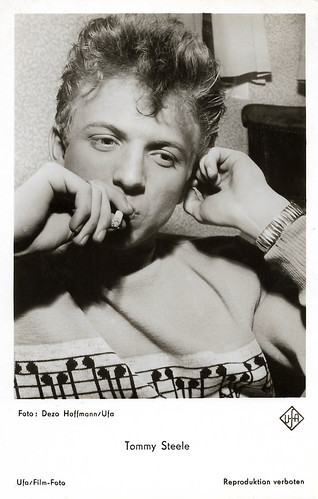
West-German postcard by Ufa/Film-Foto, Berlin-Tempelhof, no. FK 4280. Photo: Dezo Hoffmann / Ufa.
The British Answer to Elvis
Tommy Steele was born Thomas William Hicks in London, England, in 1936. He was the son of a tailor.
Tommy had tried many odd jobs before he turned up at the famous 2 I's coffee bar in London. There he was 'discovered' by manager Larry Parnes and became one of Britain's first manufactured pop stars. Parnes believed he could be Britain's answer to Elvis Presley.
Steele shot quickly to fame in the UK as the frontman for a rock and roll band, The Steelmen, after their first single, 'Rock With The Caveman', reached number 13 in the UK singles charts in 1956. His second single 'Singin' the Blues' was a number 1 hit.
His sudden stardom was compressed quickly into a film as well, The Tommy Steele Story (Gerard Bryant, 1957), even before there was a story to tell.
Most of Steele's 1950s recordings were covers of American hits, such as 'Singing the Blues' and 'Knee Deep in the Blues'. Steele co-wrote many of his early songs with Lionel Bart and Mike Pratt, but he used the pseudonym of Jimmy Bennett from 1958 onwards.
And on film, he played his Cockney self in such teen comedies as The Duke Wore Jeans (Gerald Thomas, 1958) and Tommy the Toreador (John Paddy Carstairs, 1959) with Janet Munro.
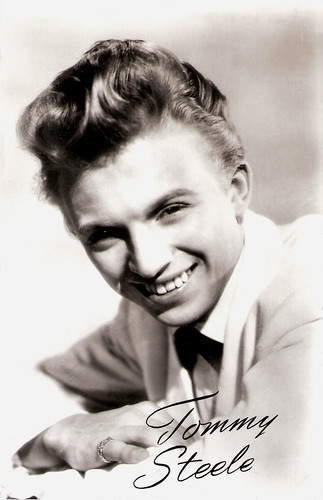
Dutch postcard by Takken, Utrecht, no. 3729.
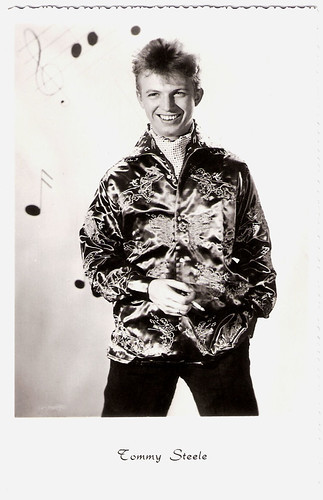
Dutch postcard by Internationale Filmpers (I.F.P.), no. 1326.
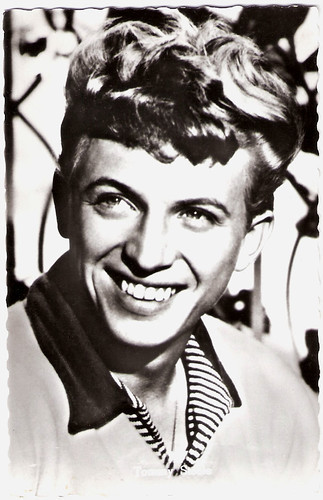
Dutch postcard by N.V. v.h. Weenenk & Snel, Baarn, no. 161. Photo: Centra.
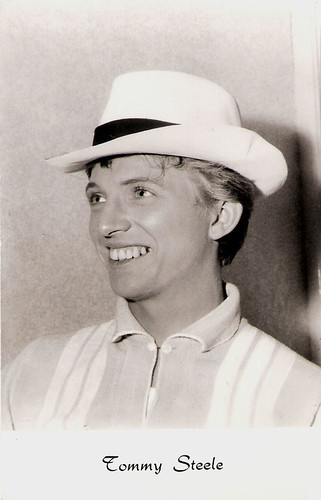
Dutch postcard by Gebr. Spanjersberg N.V., Rotterdam, no. 6083. Photo: Combi Press, Amsterdam.
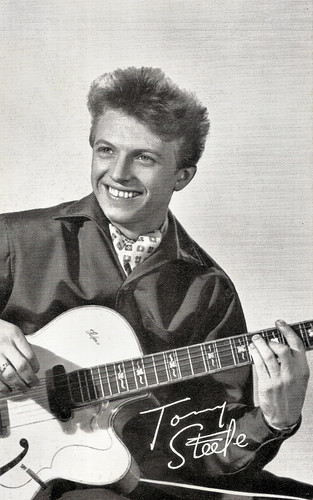
Vintage postcard.
Somewhat Overwhelming
During the 1960s Tommy Steele progressed to a career in stage and film musicals, leaving behind his pop idol identity.
He appeared in such films as Light Up the Sky! (Lewis Gilbert, 1960) with Ian Carmichael and Benny Hill, and in the West End in the title role of 'Hans Christian Andersen'.
He was nominated for Broadway's 1965 Tony Award as Best Actor (Musical) for 'Half a Sixpence' in the role of Arthur Kipps - which he later recreated for the film version of the same name, Half A Sixpence (George Sidney, 1967) with Julia Foster. One of his other co-stars was John Cleese.
Steele played character roles in The Happiest Millionaire (Norman Tokar, 1967) with Fred MacMurray and Greer Garson , and Where's Jack? (James Clavell, 1969), although many critics found his personality to be somewhat overwhelming on screen.
In Finian's Rainbow (Francis Ford Coppola, 1968), co-starring with Petula Clark and Fred Astaire, he had his best-known appearance in the cinema.

Dutch postcard by Uitg. Takken, Utrecht, no. 3280. Photo: Decca.
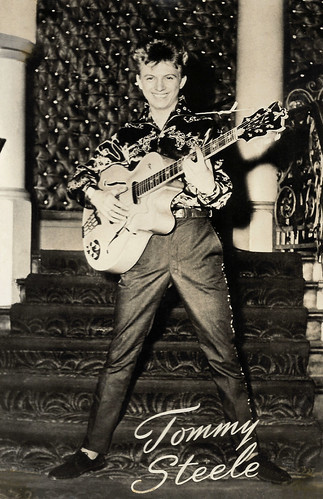
Dutch postcard by Uitg. Takken, Utrecht, no. 3764.
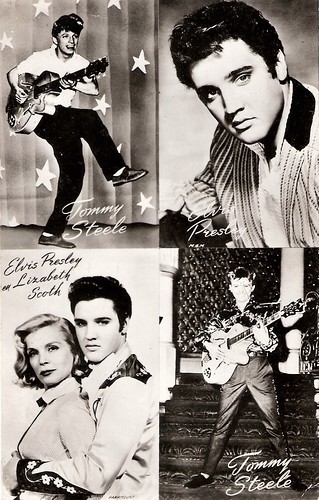
Dutch postcard by Uitg. Takken, Utrecht, no. 3823, 1958. The photo of Elvis Presley with Lizabeth Scott was a publicity still for the film Loving You (Hal Kanter, 1957).
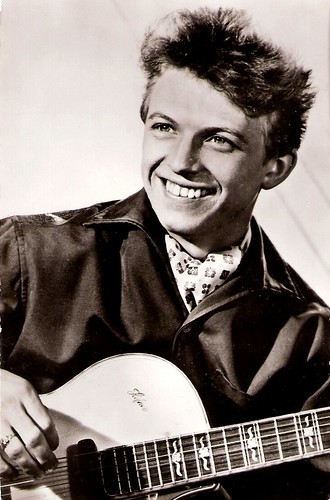
Dutch postcard.
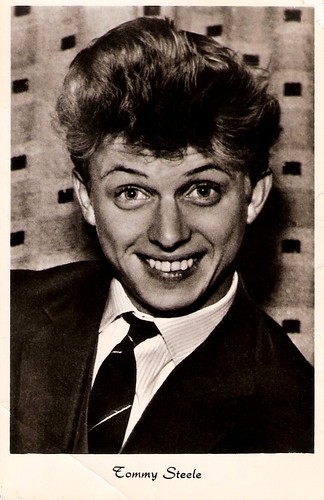
Dutch postcard by Gebr. Spanjersberg N.V., Rotterdam, no. 5194/1059.
Longest Running One-man Show in West End history
In 1979-1980, Tommy Steele's one-man show, 'An Evening with Tommy Steele', ran for fourteen months and is in the 'Guinness Book of Theatre Facts and Feats' as "the longest-running one-man show in West End history”.
In 1983, he directed and starred in the West End stage production of 'Singin' in the Rain', and in 2003-2005 he had a triumphant return on the stage as Ebenezer Scrooge in 'Scrooge: The Musical'.
In 2018, he returned to the London Coliseum, 60 years after his debut there in Rodgers and Hammerstein’s 'Cinderella', to star in 'The Glenn Miller Story'.
He was awarded the Knight Bachelor of the Order of the British Empire in the 2020 Queen's Birthday Honours List for his services to entertainment and charity.
Recalling his six-decade career, he said: “I love finding new challenges. I love taking my career into different facets like pantomime, musicals, films. I just love trying things and being invited to do it. I have always been very lucky that things have happened to me."
Tommy Steele is married to Ann Donoghue since 1960. They have one daughter, Emma.
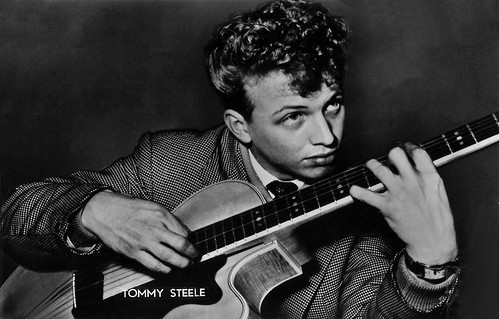
Vintage postcard. Caption: Import 212.
Tommy Steele performs 'Butterfingers' in The Tommy Steele Story (Gerard Bryant, 1957). Source: Kevin Allen (YouTube).
Tommy Steele 'Singing the blues' Source: David Jones (YouTube).
Tommy Steele performs 'Elevator Rock' in The Tommy Steele Story (Gerard Bryant, 1957). Source: Kevin Allen (YouTube).
Tommy Steele sings 'Little White Bull' in Tommy the Toreador (1959). The song is written by Lionel Bart. Source: aap 257 (YouTube).
Tommy Steele sings 'When I'm not near the girl' in Finian's Rainbow (1968) with Barbara Hancock. Source: Leighg5226 (YouTube).
Sources: Shropshire Star,
Tommy Steele

German postcard by ISV, no. H 14.

Vintage postcard.

Dutch postcard by Takken, Utrecht, no. 3248.

West-German postcard by Ufa/Film-Foto, Berlin-Tempelhof, no. CK 345. Photo: Dezo Hoffman / UFA.

West-German postcard by Ufa/Film-Foto, Berlin-Tempelhof, no. FK 4280. Photo: Dezo Hoffmann / Ufa.
The British Answer to Elvis
Tommy Steele was born Thomas William Hicks in London, England, in 1936. He was the son of a tailor.
Tommy had tried many odd jobs before he turned up at the famous 2 I's coffee bar in London. There he was 'discovered' by manager Larry Parnes and became one of Britain's first manufactured pop stars. Parnes believed he could be Britain's answer to Elvis Presley.
Steele shot quickly to fame in the UK as the frontman for a rock and roll band, The Steelmen, after their first single, 'Rock With The Caveman', reached number 13 in the UK singles charts in 1956. His second single 'Singin' the Blues' was a number 1 hit.
His sudden stardom was compressed quickly into a film as well, The Tommy Steele Story (Gerard Bryant, 1957), even before there was a story to tell.
Most of Steele's 1950s recordings were covers of American hits, such as 'Singing the Blues' and 'Knee Deep in the Blues'. Steele co-wrote many of his early songs with Lionel Bart and Mike Pratt, but he used the pseudonym of Jimmy Bennett from 1958 onwards.
And on film, he played his Cockney self in such teen comedies as The Duke Wore Jeans (Gerald Thomas, 1958) and Tommy the Toreador (John Paddy Carstairs, 1959) with Janet Munro.

Dutch postcard by Takken, Utrecht, no. 3729.

Dutch postcard by Internationale Filmpers (I.F.P.), no. 1326.

Dutch postcard by N.V. v.h. Weenenk & Snel, Baarn, no. 161. Photo: Centra.

Dutch postcard by Gebr. Spanjersberg N.V., Rotterdam, no. 6083. Photo: Combi Press, Amsterdam.

Vintage postcard.
Somewhat Overwhelming
During the 1960s Tommy Steele progressed to a career in stage and film musicals, leaving behind his pop idol identity.
He appeared in such films as Light Up the Sky! (Lewis Gilbert, 1960) with Ian Carmichael and Benny Hill, and in the West End in the title role of 'Hans Christian Andersen'.
He was nominated for Broadway's 1965 Tony Award as Best Actor (Musical) for 'Half a Sixpence' in the role of Arthur Kipps - which he later recreated for the film version of the same name, Half A Sixpence (George Sidney, 1967) with Julia Foster. One of his other co-stars was John Cleese.
Steele played character roles in The Happiest Millionaire (Norman Tokar, 1967) with Fred MacMurray and Greer Garson , and Where's Jack? (James Clavell, 1969), although many critics found his personality to be somewhat overwhelming on screen.
In Finian's Rainbow (Francis Ford Coppola, 1968), co-starring with Petula Clark and Fred Astaire, he had his best-known appearance in the cinema.

Dutch postcard by Uitg. Takken, Utrecht, no. 3280. Photo: Decca.

Dutch postcard by Uitg. Takken, Utrecht, no. 3764.

Dutch postcard by Uitg. Takken, Utrecht, no. 3823, 1958. The photo of Elvis Presley with Lizabeth Scott was a publicity still for the film Loving You (Hal Kanter, 1957).

Dutch postcard.

Dutch postcard by Gebr. Spanjersberg N.V., Rotterdam, no. 5194/1059.
Longest Running One-man Show in West End history
In 1979-1980, Tommy Steele's one-man show, 'An Evening with Tommy Steele', ran for fourteen months and is in the 'Guinness Book of Theatre Facts and Feats' as "the longest-running one-man show in West End history”.
In 1983, he directed and starred in the West End stage production of 'Singin' in the Rain', and in 2003-2005 he had a triumphant return on the stage as Ebenezer Scrooge in 'Scrooge: The Musical'.
In 2018, he returned to the London Coliseum, 60 years after his debut there in Rodgers and Hammerstein’s 'Cinderella', to star in 'The Glenn Miller Story'.
He was awarded the Knight Bachelor of the Order of the British Empire in the 2020 Queen's Birthday Honours List for his services to entertainment and charity.
Recalling his six-decade career, he said: “I love finding new challenges. I love taking my career into different facets like pantomime, musicals, films. I just love trying things and being invited to do it. I have always been very lucky that things have happened to me."
Tommy Steele is married to Ann Donoghue since 1960. They have one daughter, Emma.

Vintage postcard. Caption: Import 212.
Tommy Steele performs 'Butterfingers' in The Tommy Steele Story (Gerard Bryant, 1957). Source: Kevin Allen (YouTube).
Tommy Steele 'Singing the blues' Source: David Jones (YouTube).
Tommy Steele performs 'Elevator Rock' in The Tommy Steele Story (Gerard Bryant, 1957). Source: Kevin Allen (YouTube).
Tommy Steele sings 'Little White Bull' in Tommy the Toreador (1959). The song is written by Lionel Bart. Source: aap 257 (YouTube).
Tommy Steele sings 'When I'm not near the girl' in Finian's Rainbow (1968) with Barbara Hancock. Source: Leighg5226 (YouTube).
Sources: Shropshire Star,
October 10, 2020
Glenn Ford
Glenn Ford (1916-2006) was a Canadian-American actor whose career lasted more than 50 years. Although he played different types of roles in many film genres, Ford was best known for playing ordinary men in unusual circumstances. He was one of the biggest box-office draws of the 1940s, 1950s, and 1960s. Some of his most significant roles were in the Film Noirs Gilda (1946) and The Big Heat (1953), and the high school angst film Blackboard Jungle (1955). However, it was for comedies or Westerns which he received acting laurels, including three Golden Globe nominations for Best Actor in a Comedy, winning for Pocketful of Miracles (1961). He also played a supporting role as Clark Kent's adoptive father in Superman (1978).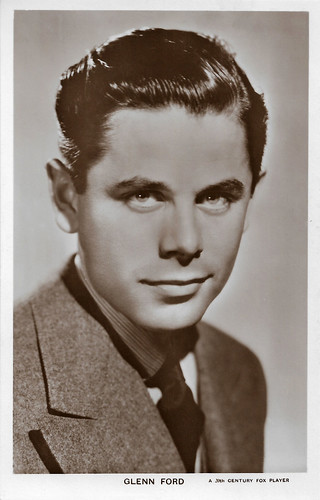
British postcard in the Picturegoer Series, London, no. 1449. Photo: 20th Century Fox.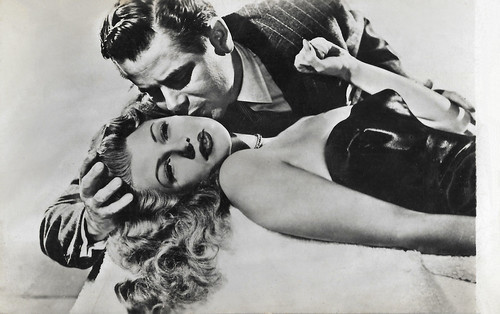
Spanish postcard. Photo: Robert Coburn / Columbia. Rita Hayworth and Glenn Ford in Gilda (Charles Vidor, 1946).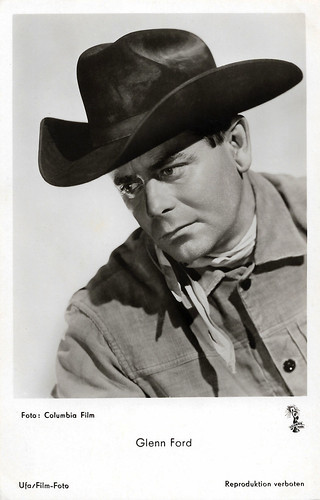
German postcard by Ufa/Film-Foto, Berlin-Tempelhof, no. FK 4245. Photo: Columbia Film. Glenn Ford in Cowboy (Delmer Daves, 1958).
Gwyllyn Samuel Newton Ford was born in 1916, in Sainte-Christine-d'Auvergne, Quebec. He was the son of Hannah Wood (née Mitchell) and Newton Ford, an engineer with the Canadian Pacific Railway.
In 1922, when Ford was six, the family moved first to Venice and then to Santa Monica, California. Newton became a motorman for the Venice Electric Tram Company, a job he held until he died at age 50 in 1940.
While attending Santa Monica High School, Glenn was active in school drama productions with other future actors such as James Griffith. After graduation, he began working in small theatre groups. While in high school, he took odd jobs, including working for Will Rogers, who taught him horsemanship.
Ford became a naturalised citizen of the United States in 1939. He acted in West Coast stage companies before joining Columbia Pictures in 1939. His stage name came from his father's hometown of Glenford, Alberta.
His first major film part was in Heaven with a Barbed Wire Fence (Ricardo Cortez, 1939). Top Hollywood director John Cromwell was impressed enough with his work to borrow him from Columbia for the independently produced drama, So Ends Our Night (1941), where Ford delivered a poignant portrayal of a 19-year-old German exile on the run in Nazi-occupied Europe.
Working with Academy Award-winning Fredric March and wooing (onscreen) 30-year-old Margaret Sullavan, recently nominated for an Oscar, Ford's shy, ardent young refugee riveted attention even in such a stellar company. "Glenn Ford, a most promising newcomer," wrote The New York Times's Bosley Crowther, "draws more substance and appealing simplicity from his role of the boy than anyone else in the cast."
After 35 interviews and glowing reviews for him personally, Glenn Ford had young female fans begging for his autograph, too. However, the young man was disappointed when Columbia Pictures did nothing with this prestige and new visibility and instead kept plugging him into conventional films for the rest of his 7-year contract.
His next picture, Texas (George Marshall, 1941), was his first Western, a genre with which he would be associated for the rest of his life. Set after the Civil War, it paired him with another young male star under contract, William Holden, who became a lifelong friend.
More routine films followed, none of them memorable, but lucrative enough to allow Ford to buy his mother and himself a beautiful new home in the Pacific Palisades.
So Ends Our Night (John Cromwell, 1941) also affected the young star in another way: in the summer of 1941, while the United States was still technically neutral, he enlisted in the Coast Guard Auxiliary. Ten months after Ford's portrait of a young anti-Nazi exile, the United States entered World War II.
After playing a young pilot in his 11th Columbia film, Flight Lieutenant (Sidney Salkow, 1942), Ford went on a cross-country 12-city tour to sell war bonds for Army and Navy Relief. In the midst of the many stars also donating their time – from Bob Hope to Cary Grant to Claudette Colbert – he met the popular dancing star, Eleanor Powell. The two soon fell in love; they attended the official opening of the Hollywood USO together in October.
Then, while making another war drama, Destroyer (William A. Seiter, 1943), with Edward G. Robinson, an ardent anti-fascist, Glenn impulsively volunteered for the United States Marine Corps Reserve in December 1942. The startled studio had to beg the Marines to give their second male lead four more weeks to complete shooting. In the meantime, Ford proposed to Eleanor Powell, who subsequently announced her retirement from the screen to be near her fiancé as he started boot camp.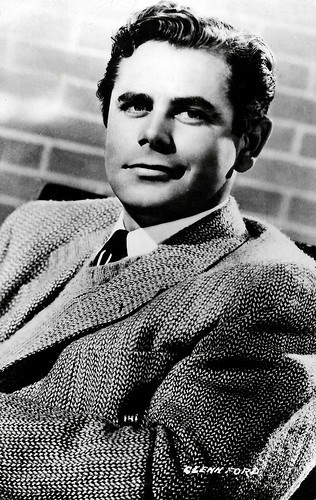
Spanish postcard, no. 141.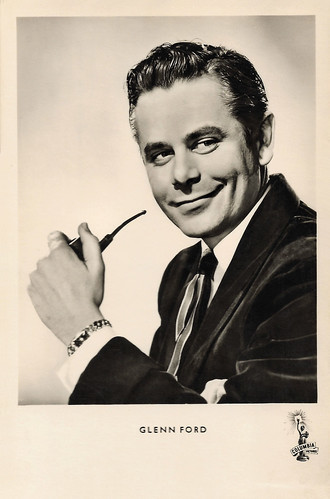
German postcard by Kunst und Bild, Berlin, no. A 121. Photo: Columbia Pictures.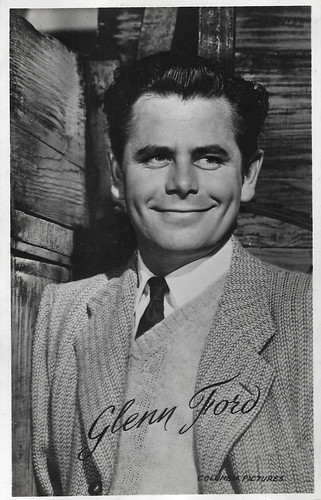
Dutch postcard. Photo: Paramount Pictures.
Glenn Ford was assigned in March 1943 to active duty at the Marine Corps Base in San Diego. With his Coast Guard service, he was offered a position as an officer, but Ford declined, feeling it would be interpreted as preferential treatment for a movie star and instead entered the Marines as a private. He trained at the Marine base in San Diego, where Tyrone Power, the number-one male movie star at the time, was also based. Power suggested Ford join him in the Marines' weekly radio show 'Halls of Montezuma', broadcast Sunday evenings from San Diego.
Ford excelled in training, winning the Rifle Marksman Badge and being named "Honor Man" of the platoon and promoted to sergeant by the time he finished. Awaiting assignment at Camp Pendleton, Marine Corps base, Ford volunteered to play a Marine raider – uncredited – in the film Guadalcanal Diary, made by Fox, with Ford and others charging up the beaches of Southern California.
After being sent to Marine Corps Schools Detachment (Photographic Section) in Quantico, Virginia, three months later, Ford returned to the San Diego base in February 1944 and was assigned to the radio section of the Public Relations Office, Headquarters Company, Base Headquarters Battalion, where he resumed work on 'Halls of Montezuma'. Though without the combat duty he had been hoping for, Ford was awarded several service medals for his three years in the Marines Reserve Corps.
The most memorable role of Ford's career came with his first postwar film, Gilda (Charles Vidor, 1946), in which he starred alongside Rita Hayworth. This was Glenn Ford's second pairing with Hayworth; his first was in The Lady In Question (Charles Vidor, 1940), a well-received courtroom drama in which Glenn plays a boy who falls in love with Rita Hayworth when his father, Brian Aherne, tries to rehabilitate her in their bicycle shop. Directed by Hungarian emigre Charles Vidor, the two rising young stars instantly bonded.
Their on-screen chemistry was not immortalised, however, until Gilda, also directed by Charles Vidor, who knew a good thing when he saw it. Ford went on to be a leading man opposite Hayworth in a total of five films, and the two, after their location romance (his marriage survived, hers did not) became lifelong friends and next-door neighbors. Beautifully shot in black-and-white by cinematographer Rudolph Mate, Gilda has endured as a classic of Film Noir.
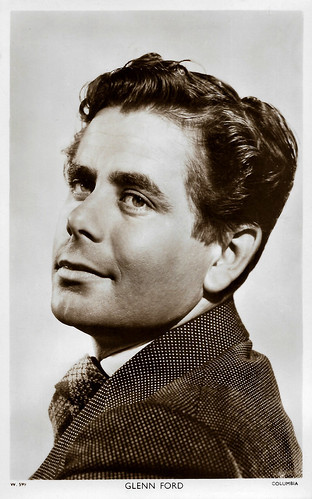
British postcard in the Picturegoer Series, London, no. W 599. Photo: Columbia.
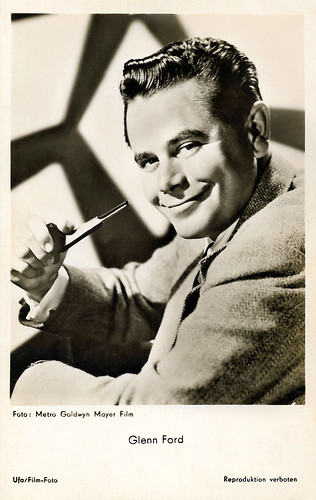
German postcard by Ufa/Film-Foto, Berlin-Tempelhof, no. FK 335. Photo: Metro Goldwyn Mayer Film.
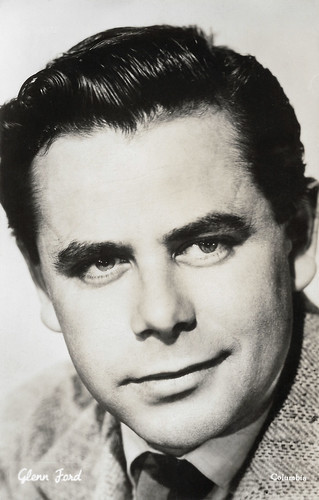
Vintage card. Photo: Columbia.
A landmark film of teen angst
Both Glenn Ford and his friend William Holden flourished throughout the 1950s and 1960s, but Ford was frustrated that he was not given the opportunity to work with directors of the caliber that Holden did in his Oscar-winning career, such as Billy Wilder and David Lean. He missed out on From Here to Eternity when production was stalled by Columbia studio head Harry Cohn. He also made the mistake, which he bitterly regretted later, of turning down the lead in the brilliant comedy Born Yesterday (George Cukor, 1950), which Holden then snatched up.
He instead continued to turn in solid performances in thrillers; dramas such as A Stolen Life (Curtis Bernhardt, 1946) with Bette Davis; action films such as Appointment in Honduras (Jacques Tourneur, 1953) with Ann Sheridan, and Film Noirs such as The Big Heat (Fritz Lang, 1953), co-starring Gloria Grahame, with whom he re-teamed the following year in Human Desire (Fritz Lang, 1954), loosely based on 'La Bête Humaine', the 1870 novel by Emile Zola.
Blackboard Jungle (Richard Brooks, 1955) was a landmark film of teen angst. It tackled racial conflicts head-on as Ford played an idealistic, harassed teacher at an urban high school that included a very young Sidney Poitier and other black and Hispanic cast members, while Vic Morrow played a dangerous juvenile delinquent. Bill Haley's 'Rock Around the Clock' under the opening credits was the first use of a rock and roll song in a Hollywood film. Richard Brooks, the film's writer and director, had discovered the music when he heard Ford's son Peter playing the record at Glenn Ford's home.
In Interrupted Melody (Curtis Bernhardt, 1955), Ford starred with Eleanor Parker. The Westerns with which he always was associated included The Secret of Convict Lake (Michael Gordon, 1951) with Gene Tierney, Jubal (Delmer Daves, 1956), The Fastest Gun Alive (Russell Rouse, 1956), 3:10 to Yuma (Delmer Daves, 1957), and Cimarron (Anthony Mann, 1960) with Maria Schell.
Ford's versatility allowed him to star in a number of popular comedies, almost always as the beleaguered, well-meaning but nonplussed straight man, set upon by circumstances as in The Teahouse of the August Moon (Daniel Mann, 1957), with Marlon Brando. He played an American soldier sent to Okinawa to convert the occupied island's natives to the American way of life and is instead converted by them. Also, he starred in Don't Go Near The Water (Charles Walters, 1957) with Gia Scala, and the romantic comedy The Courtship of Eddie's Father (Vincente Minnelli, 1963) with the young Ron Howard as his son Eddie.
In 1958, Ford was ranked the number one box-office star in America. He starred in four films that year: the Western Cowboy (Delmer Daves, 1958), the Western The Sheepman (George Marshall, 1958), the comedy Imitation General (George Marshall, 1958), and the war film Torpedo Run (Joseph Pevney, 1958).
After being nominated in 1957, 1958, and in 1962, Ford won a Golden Globe Award as Best Actor for his performance in Pocketful of Miracles (Frank Capra, 1961), a film he helped produce that was a remake of Capra's Lady for a Day (Frank Capra, 1933).
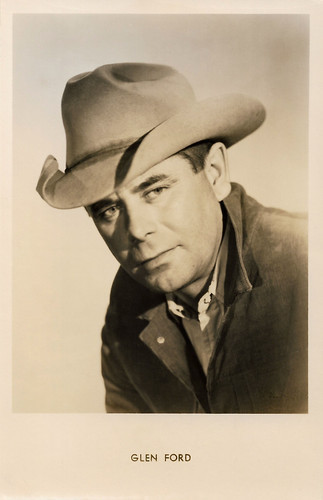
Vintage postcard, no. 141. (Ford's first name is misspelled as 'Glen'). 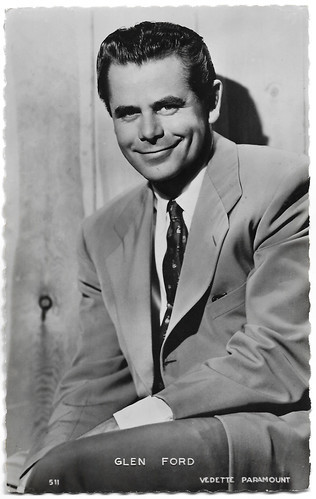
French postcard by Editions P.I., Paris, no. 511. Photo: Paramount, 1954. Ford's first name is mistakenly spelled as Glen. 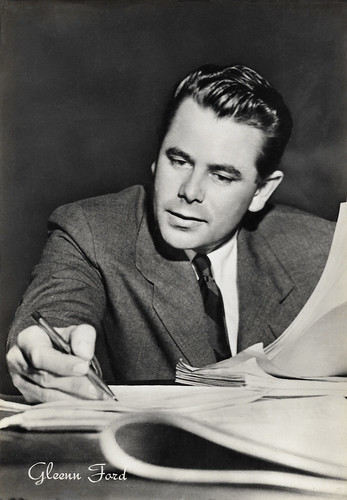
Italian postcard by Rotalfoto, Milano, no. 30. Photo: Columbia / C.E.I.A.D.. Ford's first name is mistakenly spelled as Gleenn.
In 1971, Glenn Ford signed with CBS to star in his first television series, a half-hour comedy/drama titled The Glenn Ford Show. However, CBS head Fred Silverman noticed that many of the featured films being shown at a Glenn Ford film festival were Westerns. He suggested doing a Western series, instead, which resulted in the "modern-day Western" series, Cade's County (1971–1972). Ford played southwestern Sheriff Cade for one season in a mix of police mystery and Western drama.
In The Family Holvak (1975–1976), Ford portrayed a Depression-era preacher in a family drama, reprising the same character he had played in the TV film, The Greatest Gift.
In 1978, Ford had a supporting role in Superman (Richard Donner, 1978) as Clark Kent's adoptive father Jonathan Kent. In Ford's final scene in the film, the song 'Rock Around the Clock' is heard on a car radio.
In 1981, Ford co-starred with Melissa Sue Anderson in the slasher film Happy Birthday to Me (J. Lee Thompson, 1981). In 1991, Ford agreed to star in a cable network series, African Skies. However, prior to the start of the series, he developed blood clots in his legs which required a lengthy stay in Cedars-Sinai Medical Center. Eventually, he recovered, but at one time his situation was so severe that he was listed in critical condition. Ford was forced to drop out of the series and was replaced by Robert Mitchum.
The film Superman Returns (Bryan Singer, 2006) includes a scene where Ma Kent (played by Eva Marie Saint) stands next to the living room mantel after Superman returns from his quest to find remnants of Krypton. On that mantel is a picture of Glenn Ford as Pa Kent.
Ford was married four times. His first wife was actress and dancer Eleanor Powell (1943–1959), with whom he had his only child, actor Peter Ford (1945). The couple appeared together on screen once in the short film Have Faith in Our Children (1955). When they married, Powell was more famous than Ford. She divorced him in 1959 on the grounds of adultery and mental cruelty.
He subsequently married actress Kathryn Hays (1966–1969); Cynthia Hayward (1977–1984), and Jeanne Baus (1993–1994). All marriages ended in divorces, and Ford did not remain on good terms with any of his ex-wives.
Ford was a notorious womaniser who had affairs with many of his leading ladies, including Rita Hayworth, Maria Schell, Geraldine Brooks, Stella Stevens, Gloria Grahame, Gene Tierney, Eva Gabor, and Barbara Stanwyck. He had a one-night stand with Marilyn Monroe in 1962 and a fling with Joan Crawford in the early 1940s. He also had a long-term relationship with actress Hope Lange in the early 1960s.
According to his son Peter Ford's book 'Glenn Ford: A Life' (2011), Ford had affairs with 146 actresses, all of which were documented in his personal diaries, including a 40-year, on-and-off-again affair with Rita Hayworth that began during the filming of Gilda in 1946. Their affair resumed during the making of their film The Loves of Carmen (Charles Vidor, 1948). Ford impregnated Hayworth, and she later traveled to France to get an abortion. In 1960, Ford would move next door to Hayworth in Beverly Hills, and they continued their relationship for many years until the early 1980s.
Ford also documented his many relationships by taping every phone conversation he ever had with all of his celebrity lovers and friends for 40 years. Ford installed the recording system to listen in on his first wife, Eleanor Powell's conversations, fearing that she would find out about his serial cheating and leave him.
Glenn Ford retired from acting in 1991, at age 75, following heart and circulatory problems. Ford suffered a series of minor strokes which left him in frail health in the years leading up to his death. He died in his Beverly Hills home in 2006, at the age of 90.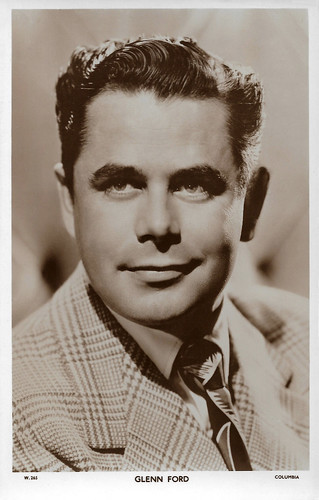
British postcard by Picturegoer, London, no. W. 265. Photo: Columbia.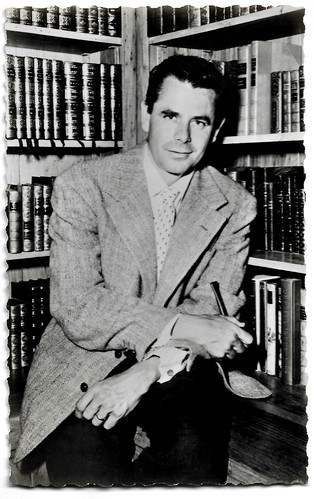
French postcard by Editions P.I., no. 844, offered by Les Carbones Korès 'Carboplane', no. 26 H (of 100). Photo: Browning Studio - H.P.S. 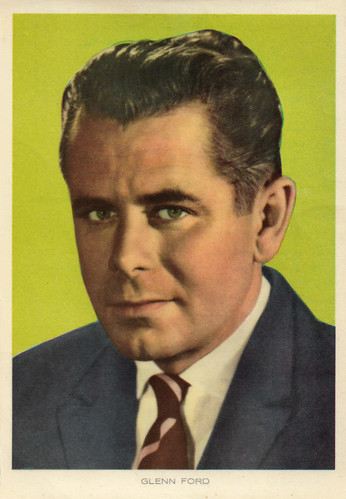
Italian postcard by Nannina, Milano, no. 30.
Sources: Wikipedia and .
October 9, 2020
Asta Nielsen by Freddy Wingårdh
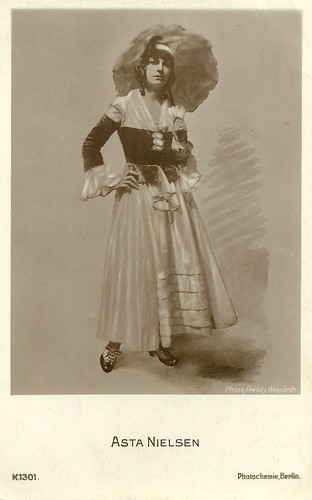
German postcard by Photochemie, Berlin, no. K. 1301. Photo: Freddy Wingårdh. Watercolour sketch of Asta Nielsen in her outfit of Dora Brandes (Magnus Stifter, 1916).
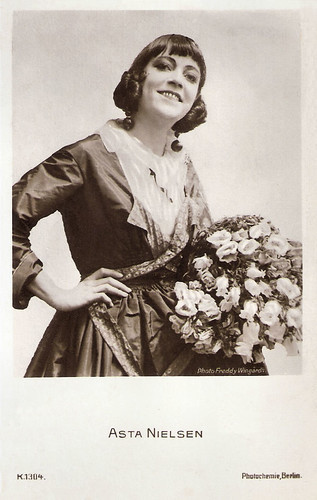
German postcard by Photochemie, Berlin, no. K. 1304. Photo: Freddy Wingårdh. Asta Nielsen wears the dress from Die Börsenkönigin/Queen of the Stock Exchange (Edmund Edel, 1915).
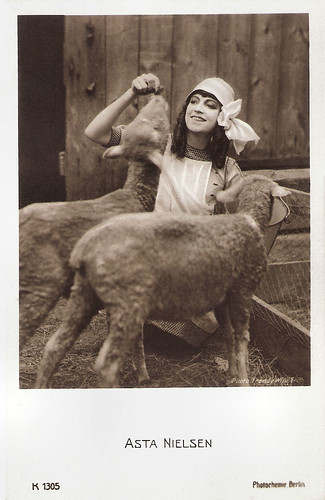
German postcard by Photochemie, Berlin, no. K. 1305. Photo: Freddy Wingårdh. Asta Nielsen in Engeleins Hochzeit/Engelein's wedding (Urban Gad, 1916).

German postcard by Photochemie, Berlin, no. K. 1308. Photo: Freddy Wingårdh.
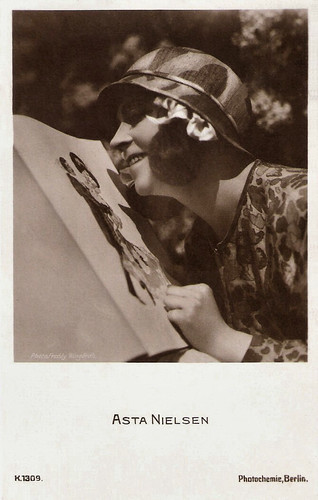
German postcard by Photochemie, Berlin, no. K. 1309. Photo: Freddy Wingårdh. Asta Nielsen in Das Liebes-ABC/The ABC of love (Magnus Stifter, 1916).
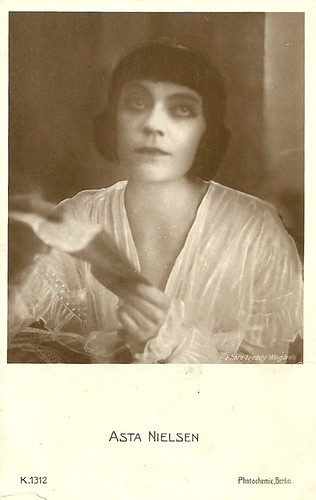
German postcard by Photochemie, Berlin, no. K. 1312. Photo: Freddy Wingårdh. Asta Nielsen in Dora Brandes (Magnus Stifter, 1916).
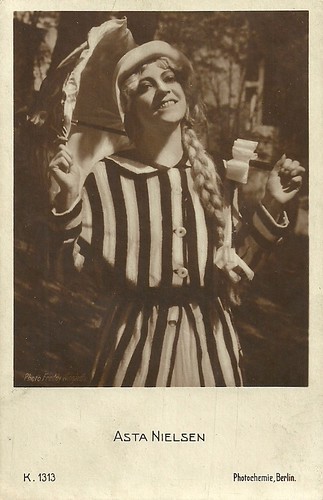
German postcard by Photochemie, Berlin, no. K. 1313. Photo: Freddy Wingårdh. Asta Nielsen in her outfit from Das Versuchskaninchen/The guinea pig (Edmund Edel, 1916).
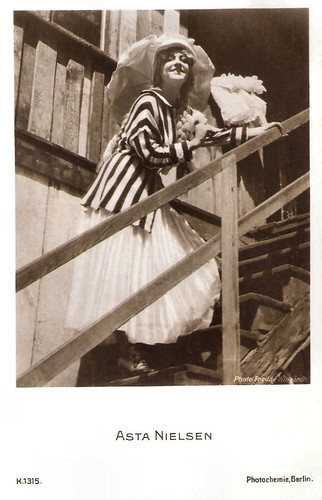
German postcard by Photochemie, Berlin, no. K. 1315. Photo: Freddy Wingårdh. Asta Nielsen in Das Versuchskaninchen/The guinea pig (Edmund Edel, 1916).
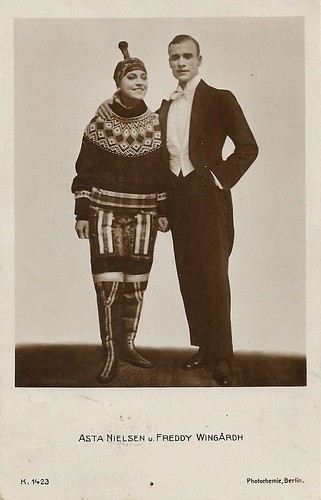
German postcard by Photochemie, Berlin, no. K. 1423. Photo: Neutral-Film. Asta Nielsen and Freddy Wingårdh in their outfits from Das Eskimobaby/The Eskimo baby (Walter Schmidthässler, 1918).
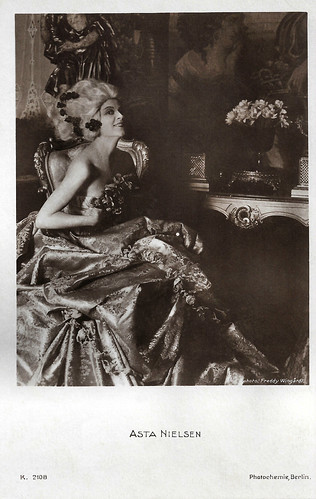
German postcard by Photochemie, Berlin, no. K. 2108. Photo: Freddy Wingårdh.
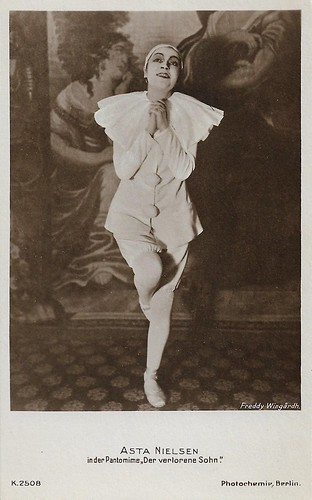
German postcard by Photochemie, Berlin, no. K. 2508. Photo: Freddy Wingårdh. Asta Nielsen in the stage pantomime 'Der verlorene Sohn' (The Lost Son, 1918).
Spurces: .
October 8, 2020
David McCallum

Spanish postcard by Ediciones Este, no. 164-T, 1966. David McCallum as U.N.C.L.E. agent Illya Kuryakin in the TV series The Man from U.N.C.L.E. (1964–1968).
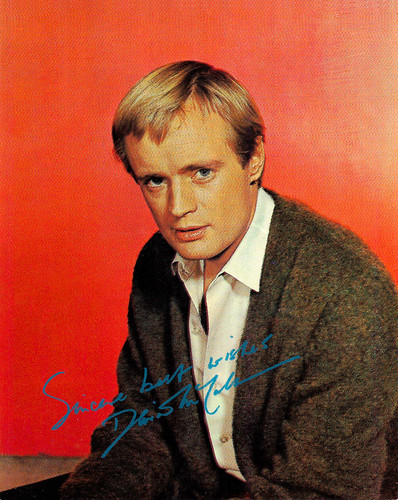
Vintage collectors Card. David McCallum as U.N.C.L.E. agent Illya Kuryakin in the TV series The Man from U.N.C.L.E. (1964–1968).

Spanish postcard by Bergas, no. 917. David McCallum as U.N.C.L.E. agent Illya Kuryakin in the TV series The Man from U.N.C.L.E. (1964–1968).
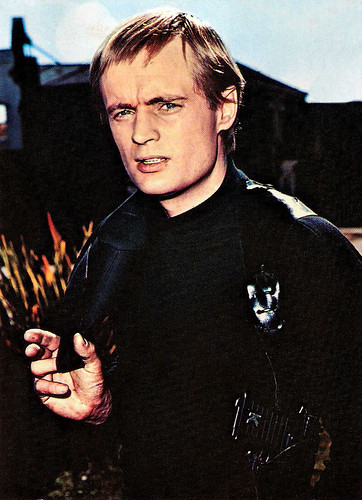
American postcard by C.G. Williams Ltd., Maidstone, Kent / Colourpicture, no. P81326. David McCallum as U.N.C.L.E. agent Illya Kuryakin in the TV series The Man from U.N.C.L.E. (1964–1968).
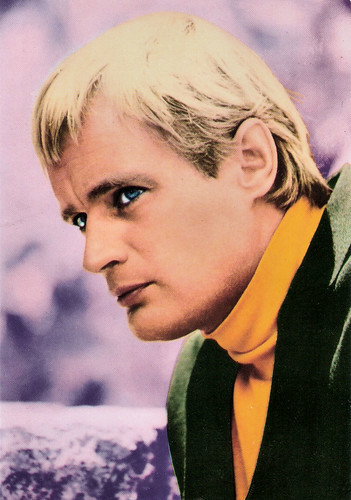
Spanish postcard by Bergas, no. 682. David McCallum as U.N.C.L.E. agent Illya Kuryakin in the TV series The Man from U.N.C.L.E. (1964–1968).
Whom the Gods Love, Die Young
David Keith McCallum was born in 1933 in Glasgow, Scotland, UK. His father, David McCallum Sr., was the first violinist for the London Philharmonic and his mother, Dorothy Dorman, was a cellist.
It's not surprising that David was originally headed for a career in music, playing the oboe. He studied briefly at the Royal Academy of Music. He left that, however, for the Royal Academy of Dramatic Art, which he attended between 1949 and 1951.
His first acting role was in 'Whom the Gods Love, Die Young' playing a doomed royal. A James Dean -themed photograph of McCallum caught the attention of the Rank Organisation, who signed him in 1956.
McCallum married actress Jill Ireland, while filming Hell Drivers (Cy Endfield, 1957) together. He made nearly a dozen films in the United Kingdom before he had his breakthrough as Lt. Wyatt in Billy Budd (Peter Ustinov, 1962), starring Terence Stamp .
His first American film was Freud: The Secret Passion (1962), directed by John Huston. In 1963 he introduced Ireland to Charles Bronson when both were filming The Great Escape (John Sturges, 1963). She subsequently left McCallum and married Bronson in 1968.
McCallum and Ireland had three sons: Paul, Jason (an adopted son who died from an accidental drug overdose in 1989), and Val (short for Valentine), who is a respected guitarist and session musician, recording and performing with such artists as Sheryl Crow.
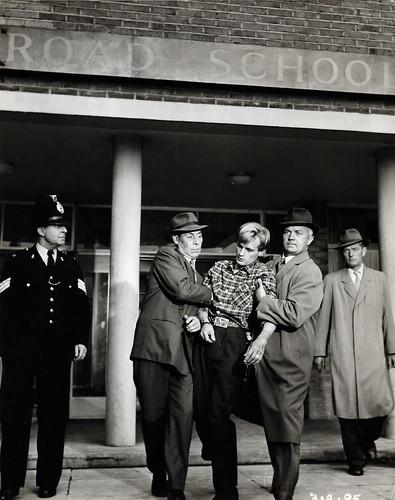
British press photo, no. 319/95. David McCallum in Violent Playground (Basil Dearden, 1958). Caption: Finally Cathie persuades her brother to give himself up to the police, and he is led away from the school and driven off in a Black Maria. At first, Cathie is distraught at the sight of her brother taken away in handcuffs. Hysterically she screams at Truman, but with the help of the Priest he manages to pacify her." "Violent Playground, the story of a Liverpool fire-raising gang, is being made for the Rank Organisation by Michael Relph and Basil Dearden, the famous team that produced The Blue Lamp. It stars Stanley Baker , David McCallum and Anne Heywood . Also in the cast are Peter Cushing and John Slater. The film is being shot on location in Liverpool and at Pinewood."
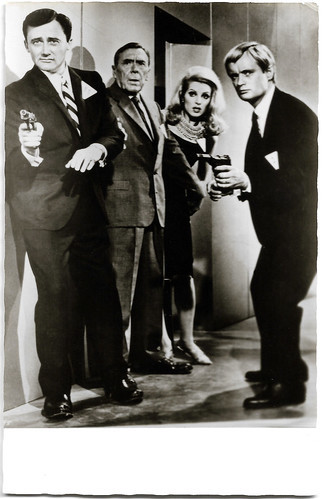
German postcard by Kolibri-Verlag, Minden/Westf., no. 2872. Robert Vaughn as U.N.C.L.E. agent Napoleon Solo, Leo G. Carroll as Alexander Waverly, Barbara Moore as Lisa Rogers, and David McCallum as U.N.C.L.E. agent Illya Kuryakin in the TV series The Man from U.N.C.L.E. (1964–1968). In Germany, the series was called 'Solo für O.N.C.E.L.' and was broadcasted by the ZDF.
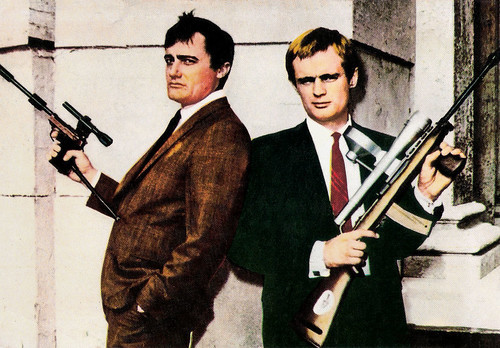
Spanish postcard by Postal Oscar Color S.A., Hospitalet (Barcelona), no. 727. Robert Vaughn and David McCallum in the American TV series The Man from U.N.C.L.E. (1964–1968).
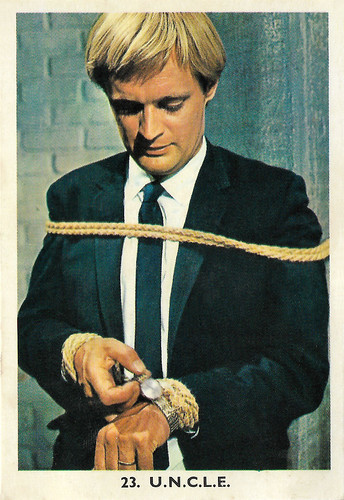
Vintage collectors card, no. 23. David McCallum as U.N.C.L.E. agent Illya Kuryakin in the TV series The Man from U.N.C.L.E. (1964–1968).
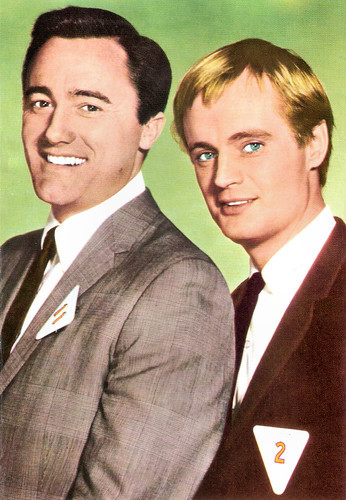
Spanish postcard by Bergas, no. 773. Photo: publicity still for the TV series The Man from U.N.C.L.E. (1964-1968) with David McCallum.
The mysterious Russian agent Illya Kuryakin
In 1964, David McCallum became a star as the mysterious Russian agent Illya Kuryakin in the hit TV series The Man from U.N.C.L.E. (1964).
The series was based on the popularity of the James Bond films. McCallum and Robert Vaughn play two top Agents of the United Network Command for Law and Enforcement (U.N.C.L.E.) who fight the enemies of peace, particularly the forces of T.H.R.U.S.H. and use charm, wit, and a never-ending assortment of gadgets.
McCallum's Beatle-style blond haircut provided a trendy contrast to Vaughn's clean-cut appearance. He became a sex symbol and his Russian alter ego became a pop culture phenomenon, despite the Cold War.
McCallum received two Emmy Award nominations in the course of the show's four-year run (1964–1968) for playing the intellectual and introvert secret agent.
McCallum also played the role of Judas Iscariot in The Greatest Story Ever Told (George Stevens, 1965). This epic is a retelling of the Biblical account about Jesus of Nazareth (Max von Sydow), from the Nativity through to the Ascension.
In the 1960s, McCallum also recorded four albums for Capitol Records with music producer David Axlerod.
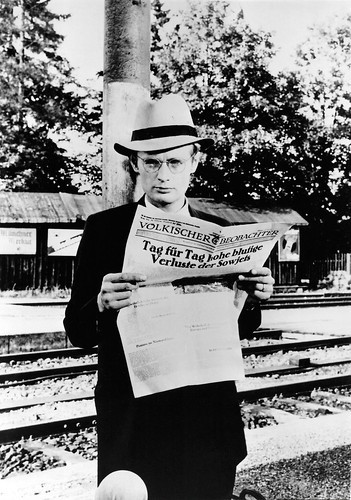
German press photo by Pressebilderdienst Kindermann, Berlin, no. 34477/1. Issued for the broadcasting at ZDF television on 15 September 1991. David McCallum in The Great Escape (John Sturges, 1963).
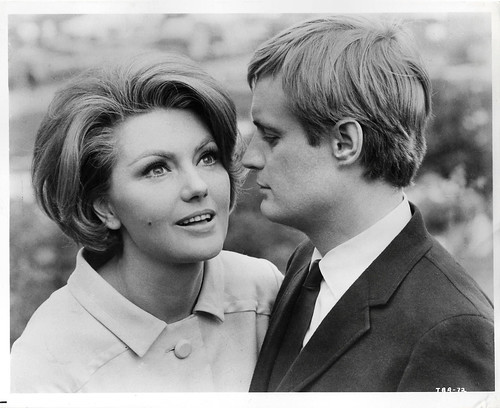
British press photo, no. 319/95. Sylva Koscina and David McCallum in Three Bites of the Apple (Alvin Ganzer, 1967).
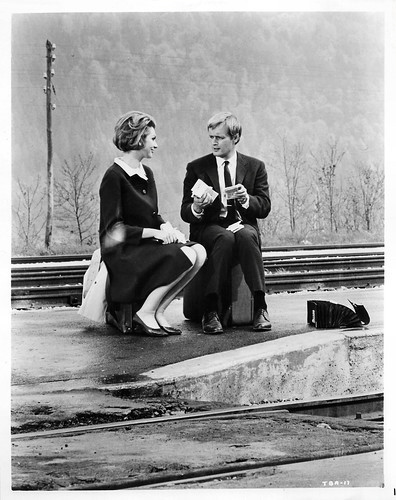
British press photo, no. TBA-17. Sylva Koscina and David McCallum in Three Bites of the Apple (Alvin Ganzer, 1967). Caption: Carla Moretti ( Sylva Koscina ), having tried to fleece tour guide Stanley Thrumm (David McCallum), has a change of heart and is happy that he has been about to retrieve his money. Romantic comedy of a tour guide in Europe whose life is turned upside-down when he wins a fortune at the gambling tables, Three Bites of the Apple stars David McCallum, Sylva Koscina and Tammy Grimes, with Harvey Korman and Domenico Modugno in co-starring roles. The Metro-Goldwyn-Mayer presentation, produced and directed by Alvin Ganzer, was filmed in Panavision and Metro-color on locations in Rome, Venice and Portofino.
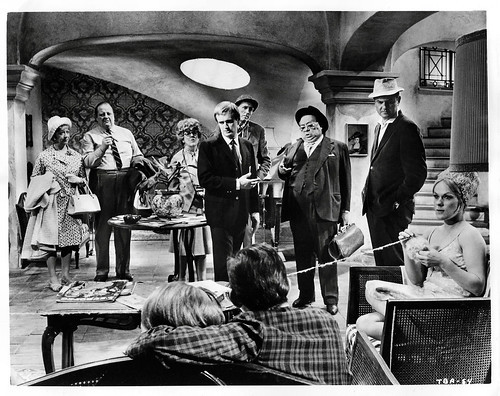
British press photo, no. TBA-54. David McCallum, Aldo Fabrizi and Tammy Grimes in Three Bites of the Apple (Alvin Ganzer, 1967). Caption: Tour guide Stanley Thrumm (David McCallum) explains to his touring party that they will be held up because of the illness of two of the members, who are being treated by the doctor (Aldo Fabrizi) at his right. Seated in lower right corner is Tammy Grimes, cast as the spinster tourist, Miss Sparrow.
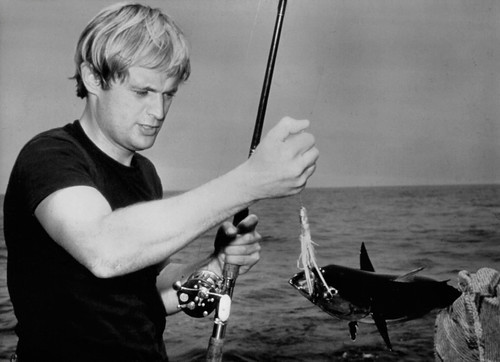
German press photo, no. D 2386/2. Photo: RTL Plus, Köln (Cologne). David McCallum in Sol Madrid/They Only Kill Once (Brian G. Hutton, 1968). The photo was issued for the TV screening of the film in Germany on 25 October 1991 under the title Kugeln sind sein Autogramm. Caption: Agent Sol Madrid (David McCallum) has a big fish on the rod. His biggest catch, however, will be a drug ring, of which the dealers will be caught in his net.
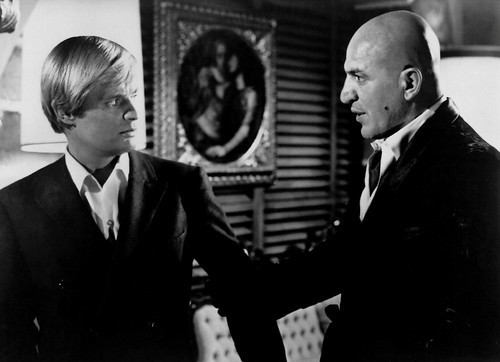
German press photo. Photo: RTL Plus, Köln (Cologne). David McCallum and Telly Savalas in Sol Madrid/They Only Kill Once (Brian G. Hutton, 1968). The photo was issued for the TV screening of the film in Germany on 25 October 1991 under the title Kugeln sind sein Autogramm.
Chief medical examiner Dr. Donald "Duckie" Mallard
For decades, David McCallum never quite repeated the popular success he had gained as Kuryakin, though he did become a familiar face on British television in such shows as Colditz (1972–1974), Kidnapped (1978), and ITV's Science-Fiction series Sapphire & Steel (1979–1982) opposite Joanna Lumley.
In 1975 he played the title character in a short-lived U.S. version of The Invisible Man. He and Robert Vaughn reprised their roles of Kuryakin and Solo in the TV film, Return of the Man from U.N.C.L.E. (1983). In 1986 they reunited again in an episode of The A-Team entitled 'The Say U.N.C.L.E. Affair'.
Finally, McCallum made a come-back with his superlative portrayal of chief medical examiner Dr. Donald "Duckie" Mallard on the hit CBS series, NCIS: Naval Criminal Investigative Service (2003) with Mark Harmon. He has played the same character in three different series: JAG (1995), NCIS: Naval Criminal Investigative Service (2003), and NCIS: New Orleans (2014).
In 2016 he published the novel 'Once a Crooked Man' (2016).
McCallum has been married to model Katherine Carpenter since 1967. They have a son, Peter, and a daughter, Sophie. McCallum and his wife are active with charitable organizations that support the United States Marine Corps: Katherine's father was a Marine who served in the Battle of Iwo Jima, and her brother lost his life in the Vietnam War.
David McCallum lives on Long Island, New York, and has six grandchildren.

Austrian press photo by Kïvesdi Presseagentur Ges., Wien for the Austrian broadcasting on 5 October 1983. David McCallum and Melinda Fee in the TV series The Invisble Man (1975). The Austrian title was Der Unsichtbare. Caption: "Rare representative of his field. Mr. Devega is a great art lover and also an ambassador. He was particularly impressed by some important paintings hanging in the Capitol. He secretly replaces them with counterfeits so that he can then blackmail the US government. He has played this game a few times and one could never prove anything ... Dan and Kate are tasked to prevent the scandal ....."
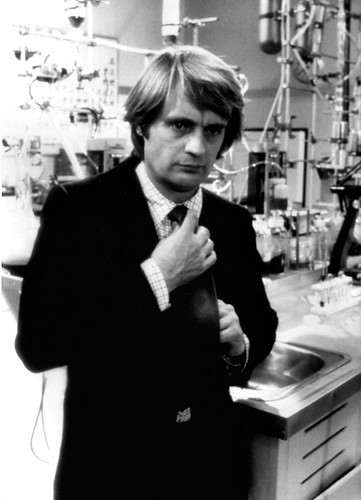
German press photo by RTL Plus for the German broadcasting on 13 December 1991. David McCallum in the TV series The Invisble Man (1975). The German title was Der Unsichtbare. Caption: Dr. Daniel Westin (David McCallum) made a sensational discovery in his research lab.
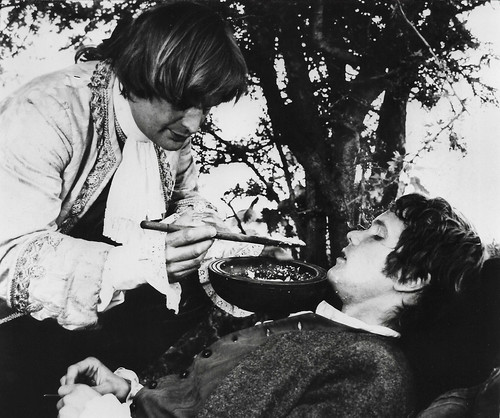
German press photo by Ursula Bunk / ZDF. David McCallum and Ekkehardt Belle in the TV Mini-series Kidnapped (Jean-Pierre Decourt, 1978), part 2. Caption: Alan (David McCallum) cares for the very weakened David (Ekkehardt Belle) and gives him something to eat. This episode was broadcasted on German television on 29 December 1984.
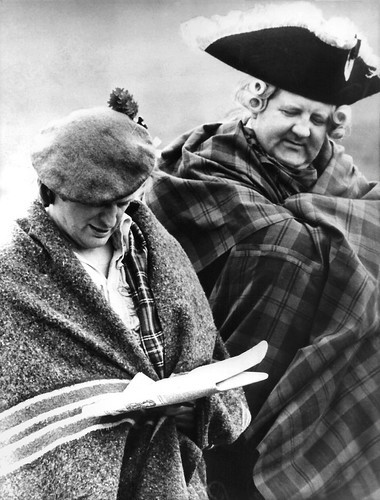
German press photo by Pressebilderdienst Kindermann / ZDF. David McCallum as Alan Breck and Bruce Purchase as Army Officer on the set of the TV Mini-series Kidnapped (Jean-Pierre Decourt, 1978), episode 2. This episode was broadcasted on German television on 10 December 1978.
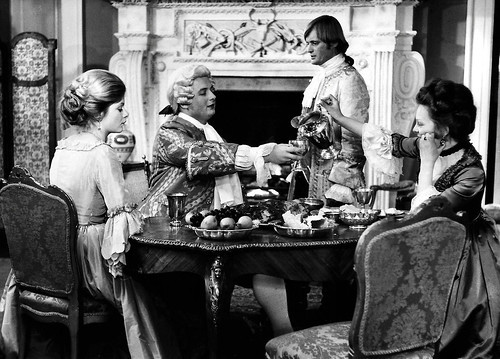
German press photo by ZDF Bilder Dienst for the broadcasting by the ZDF on 17 December 1978. David McCallum and Christopher Biggins in the TV Mini-series Kidnapped (Jean-Pierre Decourt, 1978), part 8. Caption: Alan Breck (David McCallum) is disappointed with the easy life and indifference of Prince Charles (Christopher Biggins), the Scottish heir to the throne, in France. Other actors are unknown.
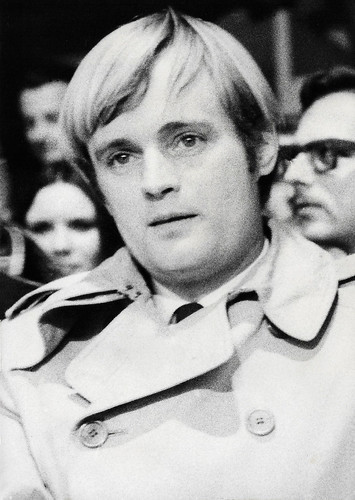
Vintage press photo.
Sources: (IMDb), Wikipedia, and .
October 7, 2020
Directed by Cecil B. DeMille

Spanish collectors card in the series 'Los artistas cinematograficos en la intimidad' by Amatller, Barcelona, Series A. From left to right: Thomas Meighan, Jeanie MacPherson, Lois Wilson, Cecil B. DeMille, Conrad Nagel, and Gloria Swanson. The photo was made during a visit to Nagel's villa, part of one of the biggest acacia plantations in California.
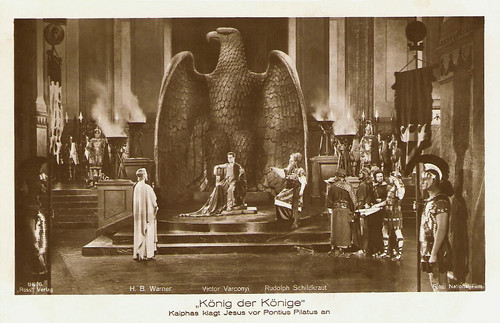
German postcard by Ross Verlag, no. 86/6. Photo: National-Film. Victor Varconi , H.B. Warner, and Rudolph Schildkraut in The King of Kings (Cecil B. De Mille, 1927). Caption: Caiphas accuses Jesus before Pontius Pilate.
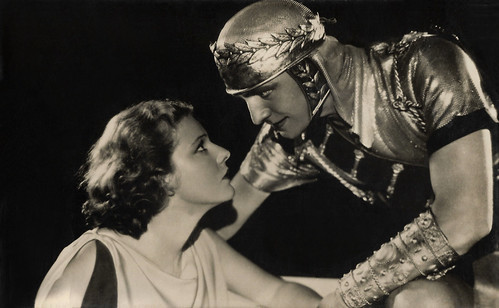
Spanish postcard, no. 1012. Elissa Landi and Fredric March in The Sign of the Cross (Cecil B. De Mille, 1932).
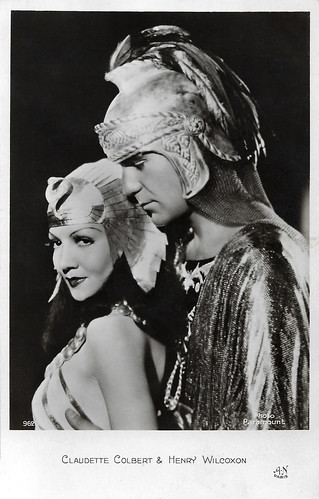
French postcard by A.N., Paris, no. 962. Photo: Paramount. Claudette Colbert and Henry Wilcoxon in Cleopatra (Cecil B. DeMille, 1934).
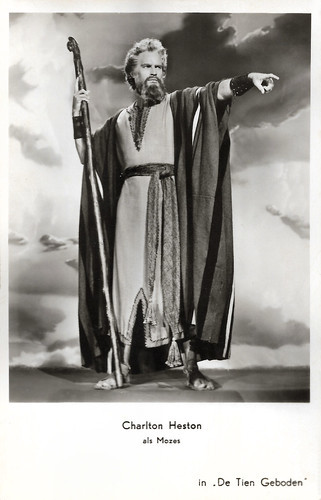
Dutch postcard by Gebr. Spanjersberg N.V., Rotterdam, no. 5183. Photo: Paramount. Charlton Heston as Moses in The Ten Commandments (Cecil B. DeMille, 1956). Moses' robe was hand-woven by Dorothea Hulse, one of the world's finest weavers. She also created costumes for The Robe, as well as textiles and costume fabrics for Samson and Delilah, David and Bathsheba, and others.
U.S. cinema's first attempts at 'motivated' lighting
Cecil Blount DeMille was born in 1881 in a boarding house on Main Street in Ashfield, Massachusetts, where his parents had been vacationing for the summer. He was the second of three children of Henry Churchill DeMille and his wife Matilda Beatrice DeMille. His brother, William C. DeMille, was born in 1878, and would later become a director too.
Cecil grew up in New York City where his father worked as a playwright, administrator, and faculty member during the early years of the American Academy of Dramatic Arts, established in New York City in 1884. DeMille's mother Beatrice was a literary agent and scriptwriter. Henry DeMille frequently collaborated with stage producer David Belasco when playwriting. Cecil gained his love of theatre while watching his father and Belasco rehearse their plays.
His father died when he was 12, and his mother supported the family by opening a school for girls and a theatrical company. DeMille attended and graduated in 1900 from the American Academy of Dramatic Arts, where he attended for free due to his father's service to the Academy. His graduation performance was the play 'The Arcady Trail'. In the audience was Charles Frohman who would cast DeMille in his play 'Hearts are Trumps', DeMille's Broadway debut.
At the age of twenty-one, Cecil B. DeMille married actress Constance Adams in 1902. They had a daughter, Cecilia, in 1908, who would be his only biological child. For twelve years he was actor/manager of his mother's theatrical company. DeMille performed on stage with actors whom he would later direct in films: Charlotte Walker, Mary Pickford , and Pedro de Cordoba.
In the 1910s, he began to direct stage productions. A collaboration of DeMille and Jesse Lasky, who was then a vaudeville producer, produced a successful musical called 'California' which opened in New York in January 1912. DeMille also produced many flops and he became disinterested in working in theatre. DeMille's passion for film was ignited when he watched the French film Les Amours de la Reine Élisabeth/Queen Elizabeth (Henri Desfontaines, Louis Mercanton, 1912) starring Sarah Bernhardt and Lou Tellegen .
Desiring a change of scene, Cecil B. DeMille, Jesse Lasky, Sam Goldfish (later Samuel Goldwyn), and a group of East Coast businessmen created the Jesse L. Lasky Feature Play Company in 1913 over which DeMille became director-general. His first film was The Squaw Man (Oscar Apfel, Cecil B. DeMille, 1914), with Dustin Farnum in the lead role. It was also the first full-length feature film shot in Hollywood. Its interracial love story made it commercially successful and it first publicised Hollywood as the home of the American film industry.
DeMille's next project was the comedy Brewster's Millions (Oscar Apfel, Cecil B. DeMille, 1914), which was wildly successful. Cecil B. DeMille's second film credited exclusively to him was the Western The Virginian (Cecil B. DeMille, 1914), again starring Dustin Farnum. DeMille had directed twenty films by 1915, including successes as Rose of the Rancho (Cecil B. De Mille, 1914) with Bessie Barriscale, and the haunted-house horror film The Ghost Breaker (Cecil B. DeMille, Oscar C. Apfel, 1914).
Wikipedia : "DeMille adapted Belasco's dramatic lighting techniques to film technology, mimicking moonlight with U.S. cinema's first attempts at "motivated lighting" in The Warrens of Virginia. This was the first of few film collaborations with his brother William." DeMille also created the posts of studio story editor, art director, and concept artist. In December 1914, Constance Adams brought home John DeMille, a fifteen-month-old, whom the couple legally adopted three years later.
DeMille's most successful film was The Cheat (Cecil B. De Mille, 1916) with Fannie Ward and Sessue Hayakawa . DeMille's direction in the film was acclaimed. In 1916, the Jesse Lasky Feature Play Company merged with Adolph Zukor's Famous Players Film Company, becoming Famous Players-Lasky. Zukor became president with Lasky as the vice president. DeMille was maintained as director-general and Goldwyn became chairman of the board.
One of its first successes was the historical epic Joan the Woman (Cecil B. De Mille, 1916) with Geraldine Farrar . It was the first film to use the Handschiegl Color Process. In 1920, DeMille and Adams adopted Katherine Lester whom Adams had found in the orphanage over which she was the director. In 1922, the couple also adopted Richard DeMille.

British postcard. Fannie Ward in The Cheat (Cecil B. DeMille, 1915).
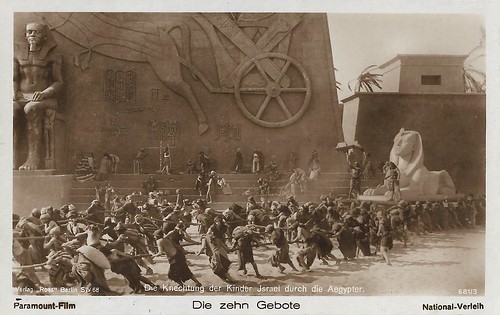
German postcard by Ross Verlag, no. 681/3. Photo: Paramount-Film / National-Verleih. Publicity still for The Ten Commandments (Cecil B. DeMille, 1923). Caption: The Slavery of the Children of Israel by the Egyptians.
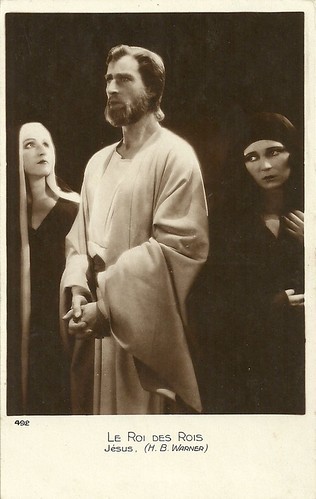
French postcard, no. 492. Jesus (H.B. Warner) between the Virgin Mary (Dorothy Cumming) and Mary Magdalene ( Jacqueline Logan ) in The King of Kings (Cecil B. DeMille, 1927).
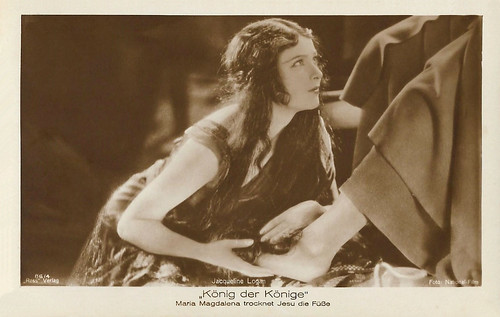
German postcard by Ross Verlag, no. 86/4. Photo: National Film. Jacqueline Logan in The King of Kings (Cecil B. deMille, 1927). Caption: Mary Magdalene dries Jesus' feet.
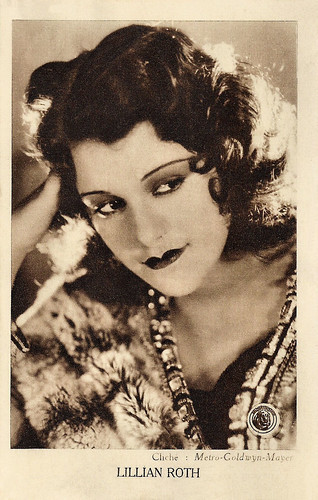
Dutch postcard by N.V. De Faam, Breda. Photo: Metro-Goldwyn-Mayer. Lillian Roth in Madam Satan (Cecil B. DeMille, 1930).
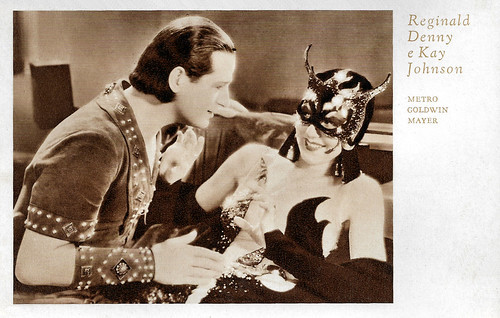
Italian postcard by Cinema-Illustrazione, Milano, Serie 2, no. 30. Photo: Metro-Goldwyn-Mayer. Kay Johnson and Reginald Denny in Madam Satan (Cecil B. DeMille, 1930).
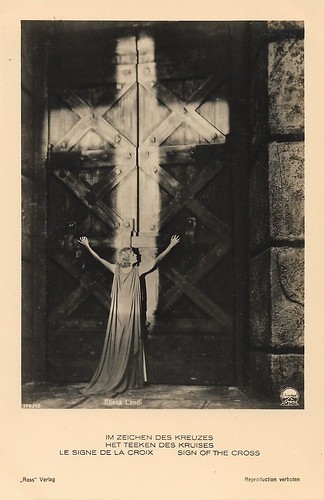
German postcard by Ross Verlag, no. 176/12. Photo: Paramount. Elissa Landi in the American epic The Sign of the Cross (Cecil B. DeMille, 1932), based on the original 1895 play by Wilson Barrett.
Master of the grandiose and of biblical sagas
After five years and thirty hit films, Cecil DeMille became the American film industry's most successful director. DeMille's trademark scenes included bathtubs, lion attacks, and Roman orgies. A number of his films featured scenes in two-color Technicolor.
His first biblical epic, The Ten Commandments (Cecil B. De Mille, 1923) starring Theodore Roberts , was both a critical and commercial success. The film was produced on a large budget of $600,000, the most expensive production at Paramount. However, the film turned out to be the studio's highest-grossing film. It held the Paramount revenue record for twenty-five years.
When a censorship board called the Hays Code was established, DeMille's depiction of on-screen immorality came under fire. DeMille left Paramount in 1924 despite having helped establish it. Instead, he joined the Producers Distributing Corporation. DeMille directed The King of Kings (Cecil B. De Mille, 1927), a biography of Jesus, which gained approval for its sensitivity and reached more than 800 million viewers. The Kings of Kings established DeMille as "master of the grandiose and of biblical sagas".
In the silent era, he was further renowned for Male and Female (Cecil DeMille, 1919) with Thomas Meighan and Gloria Swanson , Manslaughter (Cecil DeMille, 1922) with Meighan and Leatrice Joy, The Volga Boatman (Cecil DeMille, 1926) with William Boyd, and The Godless Girl (Cecil DeMille, 1928) with Marie Prevost .
When sound film was introduced in 1928, Cecil B. DeMille made a successful transition. He devised a microphone boom and a soundproof camera blimp and also popularised the camera crane. The Sign of the Cross (Cecil B. DeMille, 1932) is said to be the first sound film to integrate all aspects of cinematic technique. Cleopatra (Cecil B. DeMille, 1934) starring Claudette Colbert was his first film to be nominated for the Academy Award for Best Picture.
From 1936 to 1945 he hosted and directed the hour-long 'Lux Radio Theatre', which brought the actors and stories of many films to the airwaves and further established him as the symbol of Hollywood. In these years, his fame as a filmmaker was surpassed by his fame as a radio star. In 1939, Union Pacific (Cecil B. DeMille, 1939) was successful through DeMille's collaboration with the Union Pacific Railroad. The Union Pacific gave DeMille access to historical data, early period trains, and expert crews, adding to the authenticity of the film.
DeMille first used three-strip Technicolor in North West Mounted Police (Cecil B. DeMille, 1940). DeMille wanted to film in Canada; however, due to budget constraints, the film was instead shot in Oregon and Hollywood. Critics were impressed with the visuals but found the scripts dull, calling it DeMille's "poorest Western". Despite the criticism, it was Paramount's highest-grossing film of the year.
In 1942, DeMille released Paramount's most successful film, Reap the Wild Wind (Cecil B. DeMille, 1942). It was produced with a large budget and contained many special effects including an electronically operated giant squid. DeMille's subsequent film Unconquered (Cecil B. DeMille, 1947) with Gary Cooper , had the longest running time (146 minutes), longest filming schedule (102 days) and largest budget of $5 million. The sets and effects were so realistic that 30 extras needed to be hospitalised due to a scene with fireballs and flaming arrows. It was commercially very successful.
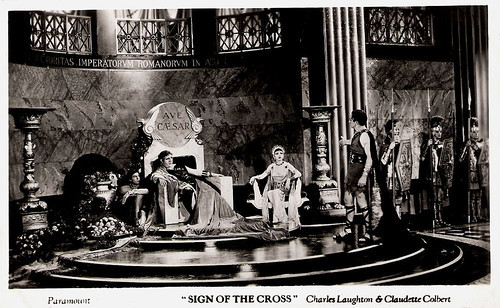
British postcard in the series Film Shots by Film Weekly. Photo: Paramount. Charles Laughton and Claudette Colbert in The Sign of the Cross (Cecil B. De Mille, 1932).
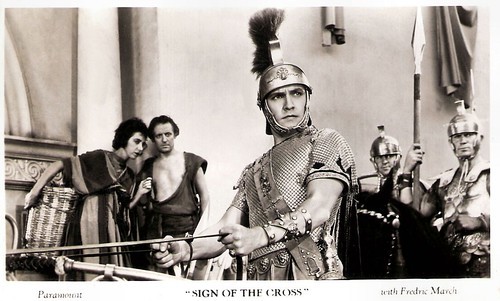
British postcard in the series Film Shots by Film Weekly. Photo: Paramount. Fredric March in The Sign of the Cross (Cecil B. De Mille, 1932).
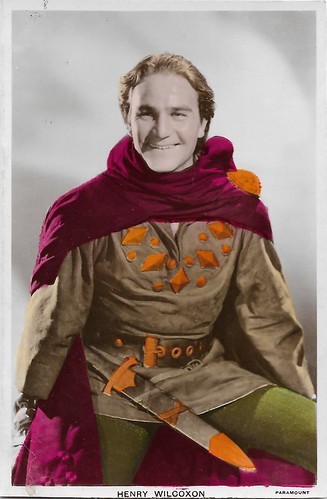
British postcard in the Colourgraph Series, no. C248. Photo: Paramount. Henry Wilcoxon as King Richard in the period piece The Crusades (Cecil B. DeMille, 1935).
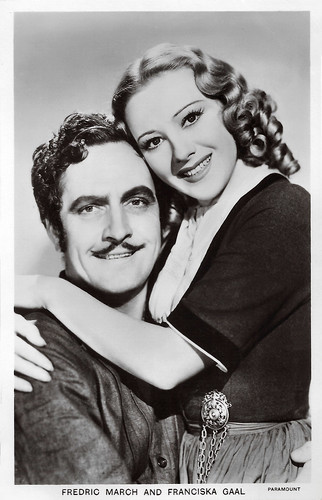
British postcard in the Film Partners Series, London, no. P 243. Photo: Paramount. Fredric March and Franziska Gaal in The Buccaneer (Cecil B. DeMille, 1938).
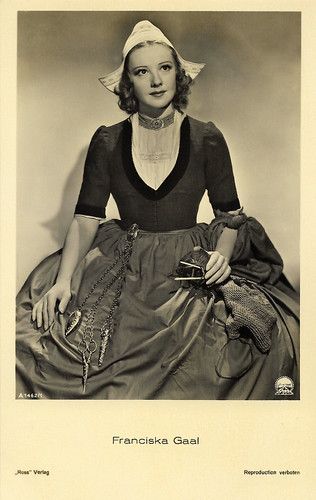
German postcard by Ross Verlag, no. A 1462/1, 1937-1938. Photo: Paramount. Franziska Gaal a.k.a. Franceska Gaal in The Buccaneer (Cecil B. DeMille, 1938).
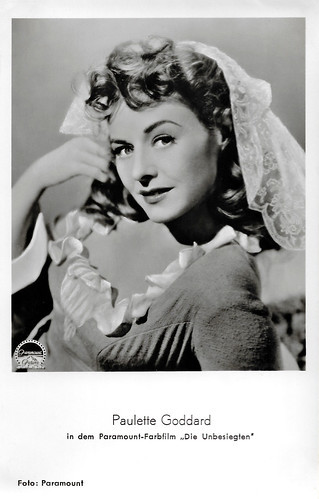
German postcard by F.J. Rüdel, Filmpostkarten-Verlag, Hamburg-Bergedorf, no. 211. Photo: Paramount. Paulette Goddard in Unconquered (Cecil B. DeMille, 1947).
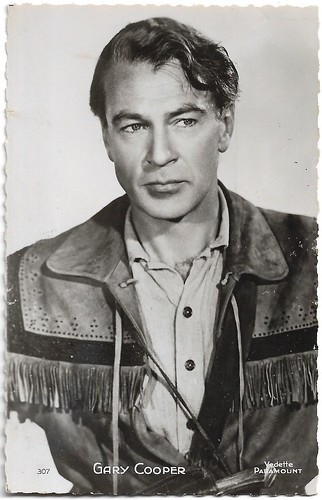
French postcard by Editions P.I., Paris, no. 307. Photo: Paramount. Gary Cooper in Unconquered (Cecil B. DeMille, 1947).
The longest and most expensive film in Paramount history
After more than thirty years in film production, Cecil DeMille reached a pinnacle in his career with Samson and Delilah (Cecil DeMille, 1949), starring Victor Mature and Hedy Lamarr . This biblical epic with sex became the highest-grossing film of 1950. He appeared as himself in the classic Sunset Boulevard (Billy Wilder, 1950) with his former star Gloria Swanson as the fictitious disturbed former silent film actress Norma Desmond.
DeMille received his first nomination for the Oscar for Best Director for his circus drama The Greatest Show on Earth (Cecil DeMille, 1952), starring James Stewart, Cornel Wilde, and Betty Hutton. It won both the Oscar and the Golden Globe for Best Picture. Ringling Brothers-Barnum and Bailey were paid $250,000 for use of the title and facilities. DeMille toured with the circus while helping write the script. Noisy and bright, it was not well-liked by critics but was a favorite among audiences.
His last and best-known film, The Ten Commandments (Cecil DeMille, 1956), starring Charlton Heston and Yul Brynner . It was the longest (3 hours, 39 minutes) and most expensive ($13 million) film in Paramount history. The Exodus scene was filmed on-site in Egypt with the use of four Technicolor-VistaVision cameras filming 12,000 people. They continued filming in 1955 in Paris and Hollywood on 30 different sound stages. Post-production lasted a year and the film premiered in Salt Lake City. Nominated for an Academy Award for Best Picture, it grossed over $80 million, which surpassed the gross of The Greatest Show on Earth and every other film in history, except for Gone with the Wind.
In 1954, while in Egypt filming the Exodus sequence, the 73-year-old DeMille climbed a 33 m ladder to the top of the massive Per Rameses set and suffered a serious heart attack. Despite the urging of his associate producer, DeMille wanted to return to the set right away. DeMille developed a plan with his doctor to allow him to continue directing while reducing his physical stress. Although DeMille completed the film, his health was diminished by several more heart attacks, and this film would be his last.
Due to his frequent heart attacks, DeMille asked his son-in-law, actor Anthony Quinn , to direct a remake of his 1938 film The Buccaneer. DeMille served as executive producer, overseeing producer Henry Wilcoxon .
Cecil B. De Mille died in 1959 following a heart attack. He was entombed at the Hollywood Memorial Cemetery, now known as Hollywood Forever. In addition to his Best Picture Awards, Cecil B. DeMille received an Academy Honorary Award for his film contributions, the Palme d'Or (posthumously) for Union Pacific (1939), a DGA Award for Lifetime Achievement, and the Irving G. Thalberg Memorial Award. He was the first recipient of the Golden Globe Cecil B. DeMille Award, which was named in his honour.
DeMille’s authority extended beyond the confines of his studio. He was a power in aviation, banking, politics, and real estate, and he was one of the 36 co-founders of the Academy of Motion Picture Arts and Sciences (AMPAS). Although married to wife Constance Adams for fifty-six years, DeMille had long-term affairs with two other women: actress-writer Jeanie MacPherson and actress Julia Faye, occasionally entertaining both women simultaneously on his yacht or his ranch. His wife knew of the affairs but preferred to live with their children in the main house.
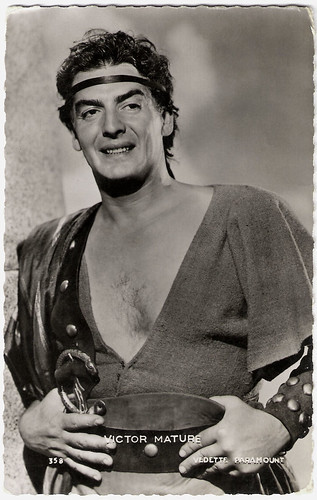
French postcard by Editions P.I., Paris, no. 358, 1954. Photo: Paramount Pictures Inc. Victor Mature in Samson and Delilah (Cecil B. DeMille, 1949).
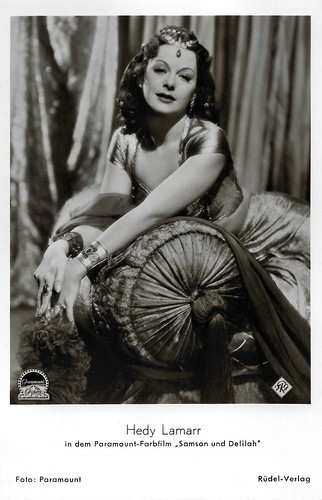
German postcard by Rüdel-Verlag, Hamburg-Bergedorf, no. 319. Photo: Paramount. Hedy Lamarr in Samson and Delilah (Cecil B. DeMille, 1949).
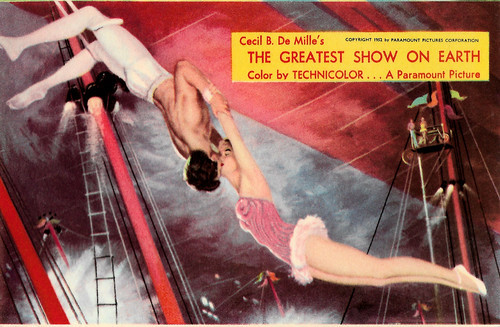
Dutch promotion card by Paramount Pictures. Photo: Paramount Pictures. Betty Hutton and Cornel Wilde in The Greatest Show on Earth (Cecil B. DeMille, 1952). Caption: Acrobatic tours in the skies of the cold-blooded Cornel Wilde and the no less skilled Betty Hutton in one of the most sensational scenes of The Greatest Show of Earth. Further protagonists are Charlton Heston, Dorothy Lamour, Gloria Grahame, and James Stewart.
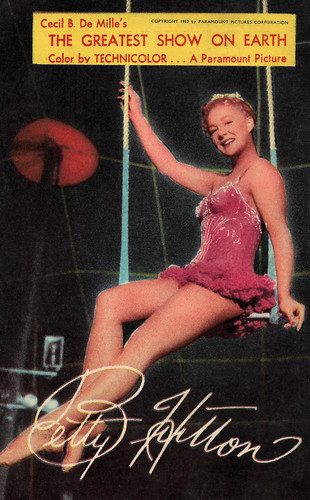
Dutch promotion card by Paramount Pictures. Photo: Paramount Pictures. Betty Hutton in The Greatest Show on Earth (Cecil B. DeMille, 1952).
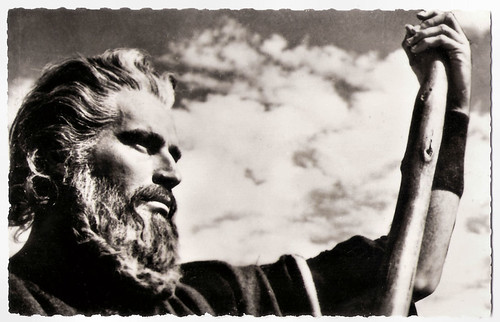
French postcard by Editions P.I., no. 830, 1956. Photo: Paramount Pictures Inc. Charlton Heston as Moses in The Ten Commandments (Cecil B. de Mille, 1956).
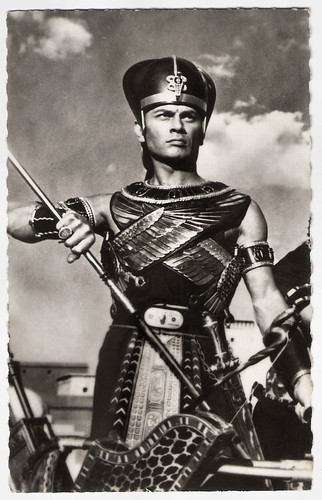
French postcard by Editions P.I., Paris, no. 831. Photo: Paramount. Yul Brynner in The Ten Commandments (Cecil B. DeMille, 1956). For his pursuit of the Israelites, Brynner in his role as Rameses II wears the blue Khepresh helmet-crown, which the pharaohs wore for battle.
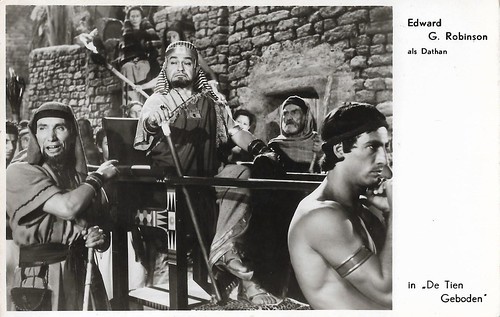
Dutch postcard. Photo: Edward G. Robinson as Dathan in The Ten Commandments (Cecil B. deMille, 1956), released in the Netherlands as De Tien Geboden.
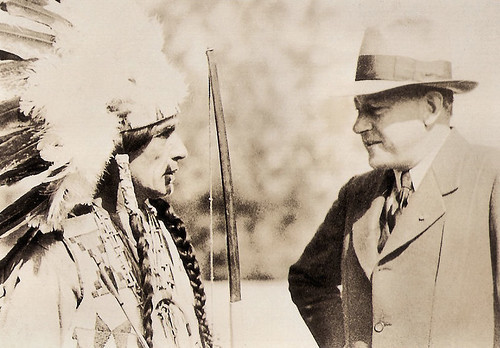
Dutch postcard, no. P. 13730. Photo: M.G.M. Cecil B. DeMille and Chief Little Bison
Sources: (IMDb), CecilBDeMille.com, Wikipedia, and
Paul van Yperen's Blog
- Paul van Yperen's profile
- 13 followers



